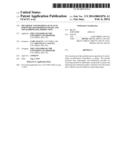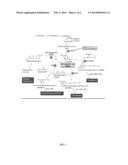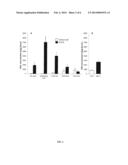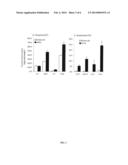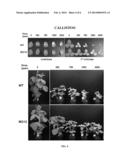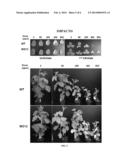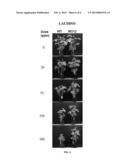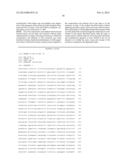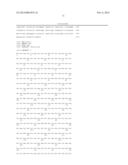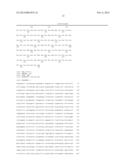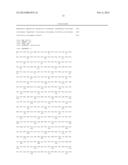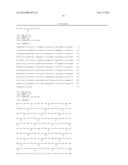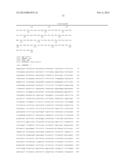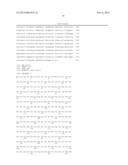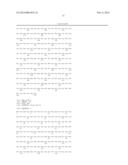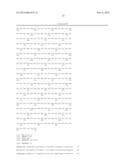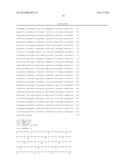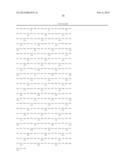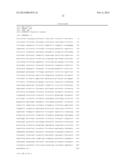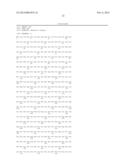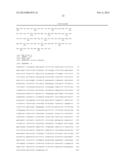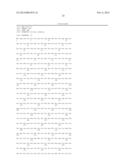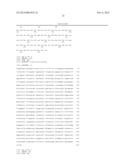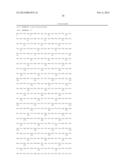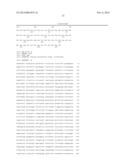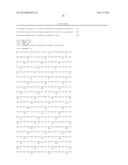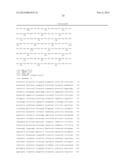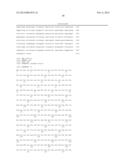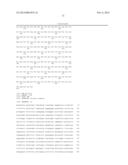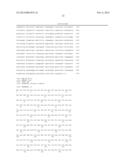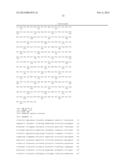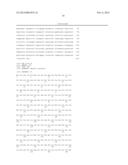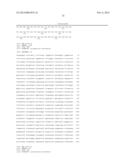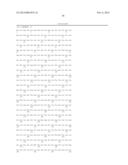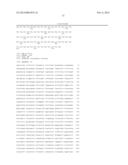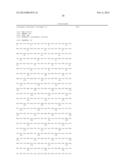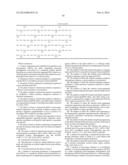Patent application title: METABOLIC ENGINEERING OF PLANTS FOR INCREASED HOMOGENTISATE AND TOCOCHROMANOL PRODUCTION
Inventors:
Gary Stacey (Columbia, MO, US)
Minviluz G. Stacey (Columbia, MO, US)
Assignees:
THE CURATORS OF THE UNIVERSITY OF MISSOURI
IPC8 Class: AC12N1582FI
USPC Class:
800260
Class name: Multicellular living organisms and unmodified parts thereof and related processes method of using a plant or plant part in a breeding process which includes a step of sexual hybridization
Publication date: 2014-02-06
Patent application number: 20140041076
Abstract:
The invention provides methods and compositions for modifying
tocochromanol biosynthesis in plants. The present invention thus
surprisingly and beneficially provides for increasing desired
tocochromanol compounds in plants and enhancing the nutritional quality
of human food and animal feed, without associate deleterious plant
phenotypes.Claims:
1. A plant comprising down-regulated homogentisic acid dioxygenase (HGO),
the plant comprising increased homogentisic acid (HGA) or a metabolic
product derived therefrom as a result of the down-regulated HGO relative
to a wild-type plant, and wherein the plant lacks deleterious
morphological traits relative to a wild type plant.
2. The plant of claim 1, wherein the plant is a soybean plant and the HGO is encoded by the gene Glyma12g20220.
3. The plant of claim 1, defined as comprising a mutation in a gene encoding said HGO.
4. The plant of claim 3, wherein the mutation comprises a deletion, a point mutation or an insertion.
5. The plant of claim 3, wherein the mutation is produced by irradiation, T-DNA insertion, transposon insertion or chemical mutagenesis.
6. The plant of claim 3, wherein the mutation comprises a mutated Glyma12g20220 allele, said allele being comprised in a representative sample of seed deposited under Accession No. PTA-12919.
7. The plant of claim 1, wherein the HGO is down-regulated by expression of an antisense or RNAi construct comprising a sequence complementary to all or a portion of a messenger RNA (mRNA) encoding said HGO.
8. The plant of claim 7, wherein said expression is developmentally-regulated, organelle-specific, inducible, tissue-specific, constitutive, cell-specific, seed-specific, or germination-specific.
9. The plant of claim 1, further comprising a transgene that encodes an enzyme catalyzing at least one step in tocopherol biosynthesis.
10. The plant of claim 9, wherein the enzyme is selected from the group consisting of: MT1, tMT2, GMT, tyrA, HPT, tocopherol cyclase, chlorophyllase, dxs, dxr, GGPPS, AANT1, LTT1, IDI, GGH, HGGT, and HST.
11. A plant part of the plant of claim 1.
12. The plant part of claim 11, further defined as a protoplast, cell, meristem, root, pistil, anther, flower, seed, embryo, stalk or petiole.
13. A seed that produces the plant of claim 1.
14. A method of increasing production of homogentisic acid (HGA) or a metabolic product derived therefrom in a plant comprising down-regulating homogentisic acid dioxygenase (HGO) in the plant relative to a wild-type plant, wherein the plant lacks deleterious morphological traits relative to a wild type plant.
15. The method of claim 14, wherein the plant is a soybean plant and the HGO is encoded by the gene Glyma12g20220.
16. The method of claim 14, wherein down-regulating comprises mutating a gene encoding said HGO.
17. The method of claim 16, wherein mutating comprises introducing a deletion, a point mutation or an insertion.
18. The method of claim 16, wherein mutating comprises irradiation, T-DNA insertion, transposon insertion or chemical mutagenesis.
19. The method of claim 14, wherein down-regulating comprises introgressing into the plant a mutated allele encoding HGO.
20. The method of claim 19, wherein said allele comprises a mutated Glyma12g20220 allele, said allele being comprised in a representative sample of seed deposited with the ATCC under Accession No. PTA-12919.
21. The method of claim 14, wherein down-regulating comprises expressing in the plant an antisense or RNAi construct comprising a sequence complementary to all or a portion of the mRNA of a gene encoding said HGO.
22. The method of claim 21, wherein said expressing is developmentally-regulated, organelle-specific, inducible, tissue-specific, constitutive, cell-specific, seed-specific, or germination-specific.
23. The method of claim 14, further comprising expressing in the plant a transgene that encodes an enzyme catalyzing at least one step in tocopherol biosynthesis.
24. The method of claim 23, wherein the enzyme is selected from the group consisting of: MT1, tMT2, GMT, tyrA, HPT, tocopherol cyclase, chlorophyllase, dxs, dxr, GGPPS, AANT1, LTT1, IDI, GGH, HGGT, and HST.
25. A method for producing a commercial product comprising obtaining a plant of claim 1 or a part thereof and producing a commercial product therefrom.
26. The method of claim 25, wherein the commercial product is protein concentrate, protein isolate, grain, soybean hulls, meal, flour or oil.
27. A method of increasing tolerance to an herbicidal inhibitor of ρ-hydroxyphenylpyruvate dioxygenase (HPPD) in a plant comprising down-regulating homogentisic acid dioxygenase (HGO) in the plant relative to a wild-type plant, wherein the plant comprises increased tolerance to an herbicidal inhibitor of ρ-hydroxyphenylpyruvate dioxygenase (HPPD) and lacks deleterious morphological traits relative to a wild type plant.
28. The method of claim 27, wherein the plant is a soybean plant and the HGO is encoded by Glyma12g20220.
29. The method of claim 27, wherein down-regulating comprises mutating a gene encoding said HGO.
30. The method of claim 27, wherein down-regulating comprises introgressing into the plant a mutated allele encoding HGO.
31. The method of claim 27, wherein down-regulating comprises expressing in the plant an antisense or RNAi construct comprising a sequence complementary to all or a portion of the mRNA of a gene encoding said HGO.
Description:
CROSS-REFERENCE TO RELATED APPLICATIONS
[0001] This applications claims the benefit of priority of U.S. Provisional Application Ser. No. 61/679,029, filed on Aug. 2, 2012, the disclosure of which is incorporated herein by reference in its entirety.
INCORPORATION OF SEQUENCE LISTING
[0003] The sequence listing that is contained in the file named "UVMO105US_ST25.txt", which is 89 kilobytes as measured in Microsoft Windows operating system and was created on Aug. 2, 2013, is filed electronically herewith and incorporated herein by reference.
BACKGROUND OF THE INVENTION
[0004] 1. Field of the Invention
[0005] The present invention relates generally to the field of plant genetics and biochemistry. More particularly, it concerns methods and compositions for modifying homogentisic acid (HGA) and tocochromanol content in plants.
[0006] 2. Description of Related Art
[0007] Tocochromanols such as Vitamin E are a group of plant-derived, lipid-soluble compounds with strong antioxidant activities. Since humans and animals cannot produce vitamin E, it has to be supplied in the daily diet. In addition to vitamer activity in fertility cases, there is a growing body of literature indicating that the strong anti-oxidative activity of tocochromanols is effective in counteracting the onset or progression of human diseases such as cancer and cardio-vascular diseases. For these reasons, biofortification of plants for increased vitamin E content has been conducted in both academic and industrial laboratories.
SUMMARY OF THE INVENTION
[0008] In one aspect, the invention provides a plant in which a gene encoding homogentisic acid (HGA) dioxygenase (HGO) is down-regulated to confer increased HGA content, or a metabolic product derived therefrom, wherein the plant lacks deleterious morphological traits relative to a wild-type plant. In one embodiment, the plant is a soybean plant and the gene is the Glyma12g20220 gene. In other embodiments, such a plant comprises a non-transgenic mutation in the Glyma12g20220 gene resulting in the down-regulation. In still other embodiments of the invention, the mutation comprises a deletion, point mutation, or an insertion. In one embodiment of the invention, the mutation is produced by irradiation, T-DNA insertion, transposon insertion, or chemical mutagenesis.
[0009] In another aspect, a Glyma12g20220 or other HGO gene is down-regulated by expression of an antisense or RNA interference (RNAi) construct comprising a sequence complementary to all or a portion of an HGO gene messenger RNA (mRNA). In one embodiment of the invention, expression of such a construct is developmentally-regulated, organelle-specific, inducible, tissue-specific, constitutive, cell-specific, seed-specific, or germination-specific. In this manner, HGA and tocochromanol production may be engineered to specific portions of a plant, or at different developmental time. By manipulating specific steps in the metabolism of HGA and metabolites derived therefrom, different tocochromanols can be produced in different tissue types or different times.
[0010] In another aspect, plants in which an HGO gene such as Glyma12g20220 gene is down-regulated further comprises at least a first transgene that encodes an enzyme catalyzing at least one step in tocochromanol biosynthesis. In certain embodiments of the invention, the enzyme is selected from the group consisting of: MT1, tMT2, GMT, tyrA, HPT, tocopherol cyclase, chlorophyllase, dxs, dxr, GGPPS, AANT1, LTT1, IDI, GGH, HGGT, and HST.
[0011] In another aspect, the invention further relates to a plant part of a plant in which HGO is down-regulated. In one embodiment of the invention, the part of the plant is further defined as a protoplast, cell, meristem, root, pistil, anther, flower, seed, embryo, stalk or petiole. In another aspect, the invention further relates to a seed that produces a plant in which Glyma12g20220 or another HGO gene is down-regulated in accordance with the invention.
[0012] In yet another aspect, the invention provides a method of increasing production of HGA or a metabolic product derived therefrom in a plant comprising down-regulating HGO relative to an otherwise isogenic wild-type plant, wherein the plant in which down-regulating occurs lacks deleterious morphological traits relative to a wild-type plant. Non-limiting examples of such deleterious traits may include one or more of reduced germination, reduced vigor, reduced yield, and reduced hardiness to biotic or abiotic stress relative to an otherwise isogenic plant lacking the down-regulation. In one embodiment of such a method, the down-regulating comprises mutating a Glyma12g20220 gene or other HGO gene. In one embodiment of the invention, mutating comprises introducing a deletion, a point mutation, or an insertion in a wild-type Glyma12g20220 gene.
[0013] In another aspect of the invention, down-regulating HGO comprises introgressing into a plant or any given variety a mutated HGO allele. In a specific embodiment, the mutated allele comprises the mutated Glyma12g20220 allele contained in a representative sample of seed of the plant designated MO12 deposited with the ATCC under Accession No. PTA-12919. In another embodiment of the invention, down-regulating comprises expressing in the plant an antisense or RNAi construct comprising a sequence complementary to all or a portion of a HGO messenger RNA (mRNA). In one embodiment of the invention, expressing is developmentally-regulated, organelle-specific, inducible, tissue-specific, constitutive, cell-specific, seed-specific, or germination-specific.
[0014] In another aspect, the invention further relates to expressing in the plant in which the HGO gene is down-regulated a transgene that encodes an enzyme catalyzing at least one step in tocopherol biosynthesis.
[0015] In yet another aspect, the invention provides a method for producing a commercial product comprising obtaining a plant of the invention in which HGO is down-regulated, or a part thereof, and producing a commercial product therefrom. In one embodiment of the invention, commercial products include protein concentrate, protein isolate, grain, hulls, meal, flour or soil.
[0016] In further aspects, the plant comprises an antisense or RNAi construct comprising a DNA molecule complementary to all or a portion of a HGO mRNA, wherein the DNA molecule down-regulates the function of the gene relative to a plant lacking the DNA molecule. In one embodiment of the invention, a DNA molecule is operably linked to a developmentally-regulated, organelle-specific, inducible, tissue-specific, constitutive, cell-specific, seed specific, or germination-specific promoter.
[0017] In yet another aspect, the present invention provides a method of conferring at least a first altered agronomic property to a plant comprising down-regulating an HGO gene function in the plant relative to a plant in which HGO gene function is not down-regulated. In one embodiment of the invention, altered agronomic properties can include increased HGA, increased vitamin E, increased isoforms of vitamin E, increased precursors of vitamin E, increased tocochromanols, increased tocopherols, increased γ-tocopherols, increased β-tocopherols, and increased tocotrienols.
[0018] Embodiments discussed in the context of methods or compositions of the invention may be employed with respect to any other method or composition described herein. Thus, an embodiment pertaining to one method or composition may be applied to other methods and compositions of the invention as well.
[0019] As used herein the terms "encode" or "encoding" with reference to a nucleic acid are used to make the invention readily understandable by the skilled artisan however these terms may be used interchangeably with "comprise" or "comprising" respectively.
[0020] As used herein the specification, "a" or "an" may mean one or more. As used herein in the claim(s), when used in conjunction with the word "comprising", the words "a" or "an" may mean one or more than one.
[0021] The use of the term "or" in the claims is used to mean "and/or" unless explicitly indicated to refer to alternatives only or the alternatives are mutually exclusive, although the disclosure supports a definition that refers to only alternatives and "and/or." As used herein "another" may mean at least a second or more.
[0022] Other objects, features and advantages of the present invention will become apparent from the following detailed description. It should be understood, however, that the detailed description and the specific examples, while indicating preferred embodiments of the invention, are given by way of illustration only, since various changes and modifications within the spirit and scope of the invention will become apparent to those skilled in the art from this detailed description.
BRIEF DESCRIPTION OF THE DRAWINGS
[0023] The following drawings form part of the present specification and are included to further demonstrate certain aspects of the present invention. The invention may be better understood by reference to one or more of these drawings in combination with the detailed description of specific embodiments presented herein.
[0024] FIG. 1 shows the tocochromanol biosynthetic pathway in plants. The immediate steps in HGA formation and its utilization for central metabolism or tocochromanol production are numbered. HPPD=ρ-hydroxyphenylpyruvate dioxygenase; HGGT=HGA geranylgeranyl transferase; HPT=HGA phytyl transferase; HST=HGA solanesyl transferase; VTE1=tocopherol cyclase; VTE3=MPBQ/MSBQ methyl transferase; VTE4=γ-tocopherol methyl transferase.
[0025] FIG. 2 shows mutations in HGA dioxygenase (HGO) result in increased HGA accumulation in various (A) soybean tissues and in (B) Arabidopsis seeds. Soybean cultivar MO12 carries a deletion in Glyma12g20220 whereas Arabidopsis line hgo1-1 carries a T-DNA insertion in At5g54080. Williams 82 and Col-0 are the unmodified parental lines for the soybean and Arabidopsis mutants, respectively. HGA concentrations were determined by LC-MS. Standard deviation for each data is shown.
[0026] FIG. 3 shows tocochromanol content in Williams 82 (wild type) and MO12 seeds.
[0027] FIG. 4 shows increased resistance of MO12 plants to the commercial herbicide CALLISTO® (Syngenta Crop Protection, USA), which inhibits 4-hydroxyphenylpyruvate dioxygenase (4-HPPD), as compared to Williams 82 (WT).
[0028] FIG. 5 shows increased resistance of MO12 plants to the commercial herbicide IMPACT® (IMVAC, USA), which inhibits 4-hydroxyphenylpyruvate dioxygenase (4-HPPD), as compared to Williams 82 (WT).
[0029] FIG. 6 shows increased resistance of MO12 plants to the commercial herbicide LAUDIS® (Bayer CropScience, USA), which inhibits 4-hydroxyphenylpyruvate dioxygenase (4-HPPD), as compared to Williams 82 (WT).
BRIEF DESCRIPTION OF THE SEQUENCES
[0030] Homogentisic acid dioxygenase (HGO) cDNA and protein sequences from selected plants.
SEQ ID NO: 1--cDNA sequence of Glyma12g20220 Glycine max (soybean) SEQ ID NO: 2--protein sequence SEQ ID NO: 3--cDNA sequence of Glyma06g34940.1 SEQ ID NO: 4--protein sequence SEQ ID NO: 5--cDNA sequence of Glyma06g34890.1 SEQ ID NO: 6--protein sequence SEQ ID NO: 7--cDNA sequence of LOC_Os06g01360 Oryza sativa (rice; Japonica Group) SEQ ID NO: 8--protein sequence SEQ ID NO: 9--protein sequence LOCUS ID: OsI--21275 Oryza sativa (rice; Indica Group) SEQ ID NO: 10--cDNA sequence of GRMZM2G154093 Zea mays (corn) SEQ ID NO: 11--protein sequence SEQ ID NO: 12--cDNA sequence of Phvulv091012528m Phaseolus vulgaris (common bean) SEQ ID NO: 13--protein sequence SEQ ID NO: 14--cDNA sequence of 30209.m001534 Ricinus communis (castor oil) SEQ ID NO: 15--protein sequence SEQ ID NO: 16--cDNA sequence of Lus 10042839 Common flax or linseed SEQ ID NO: 17--protein sequence SEQ ID NO: 18--cDNA sequence of POPTR--0001s38310.1 Populus trichocarpa (Western Balsam poplar or California poplar) SEQ ID NO: 19--protein sequence SEQ ID NO: 20--cDNA sequence of Sb10g000360.1 Sorghum bicolor (sorghum) SEQ ID NO: 21--protein sequence SEQ ID NO: 22--cDNA sequence of Pavirv00023476m Panicum virgatum (switchgrass) SEQ ID NO: 23--protein sequence SEQ ID NO: 24--cDNA sequence of cassava4.1--012571m Manihot esculenta (cassava) SEQ ID NO: 25--protein sequence SEQ ID NO: 26--cDNA sequence of homogentisate 1,2-dioxygenase (HGO; GenBank Accession No. AF149017) Lycopersicon esculentum SEQ ID NO: 27--protein sequence GenBank Accession No. AAF73132.1 SEQ ID NO: 28--cDNA sequence of AT5G54080 Arabidopsis thaliana SEQ ID NO: 29--protein sequence
DETAILED DESCRIPTION OF THE INVENTION
[0031] The present invention provides methods and compositions for increased homogentisic acid (HGA) and tocochromanol metabolites thereof in plants without deleterious morphological traits associated with prior attempts to engineer tocochromanols in plants. In certain aspects this comprises down-regulating the expression of HGA dioxygenase (HGO) encoded by the Glyma12g20220 gene. The present invention thus surprisingly and beneficially provides for: 1) increasing tocopherol and tocotrienol concentration in plants; 2) enhancing the nutritional quality of human food and animal feed; 3) increasing the ability of plants to cope with abiotic and biotic stresses. In certain aspects the invention may also be used to provide increased tolerance of plants to certain classes of herbicides, such as HPPD inhibitor herbicides (FIGS. 4, 5, and 6).
[0032] The tocochromanol biosynthetic pathway in higher plants, which includes tocopherol, tocotrienols and plastochromanol-8, involves a number of enzymes (Table 1). HGO, however, catalyzes the conversion of HGA to 4-maleylacetoacetate and thus reduces the pool of available HGA for tocochromanol biosynthesis. HGA is a common precursor to both tocopherols and plastoquinones. The plastids of higher plants exhibit interconnected biochemical pathways leading to secondary metabolites including tocopherols (FIG. 1). The various genes and their encoded proteins involved in tocopherol biosynthesis are listed in Table 1.
TABLE-US-00001 TABLE 1 Tocochromanol biosynthesis coding regions and enzymes. Coding region or Enzyme Abbreviation Enzyme name tyrA Mono or bifunctional prephenate dehydrogenase HPT Homogentisate prenyl transferase DXS 1-Deoxyxylulose-5-phosphate synthase DXR 1-Deoxyxylulose-5-phosphate reductoisomerase GGPPS Geranylgeranyl pyrophosphate synthase HPPD p-Hydroxyphenylpyruvate dioxygenase AANT1 Adenylate transporter IDI Isopentenyl diphosphate isomerase MT1 Bacterial 2-methylphytylplastoquinol tMT2 Plant 2-methylphytylplastoquinol methyltransferase GGH Geranylgeranyl diphosphate reductase Slr1737 Tocopherol cyclase GMT Tocopherol gamma methyl transferase LTT1 Phytol kinase Chl1 and Chl2 Chlorophyllase 1 and 2 HGGT HGA geranylgeranyl transferase HST HGA solanesyl transferase
[0033] The synthesis of all tocochromanols is initiated by the conversion of 4-hydroxyphenylpyruvate (HPP) into homogentisic acid (HGA) catalyzed by HPP dioxygenase (HPPD). The Shikimate pathway that synthesizes HPP from chorismate is under feedback inhibition, limiting the flux of HPP and hence also limiting HGA formation. HGA can be prenylated for the formation of the various vitamin E isoforms (i.e. tocopherols, tocotrienols and plastochromanol-8) or it can be oxidized to 4-maleylacetoacetate which is eventually funneled to central metabolism as acetoacetate and fumarate (FIG. 1). The present inventors show that a large portion of synthesized HGA is converted to 4-maleylacetoacetate and that manipulations to prevent the formation of functional HGA dioxygenase (HGO) result in significantly increased HGA flux in plants.
[0034] The present invention thus provides methods that increases HGA flux by blocking the pathway towards 4-maleylacetoacetate formation from HGA, and can be applied to other agronomically important crops besides soybean. Moreover, this invention covers any genetic manipulations to disrupt the formation of functional HGO enzymes in plants.
[0035] Efforts aimed at the biofortification of plants for increased vitamin E content have elucidated that one major factor limiting increased vitamin E production by plants is the accumulation of the metabolite HGA. The present invention represents a novel approach of increasing HGA accumulation in plants. HGA content is increased in various tissues and in seeds of soybean. For example, in soybean, deletion of gene Glyma12g20220 (encoding HGO) in cultivar MO12 (derived from cv. Williams 82) resulted in a 31- and 124-fold increase in HGA accumulation in mature and green seeds (stage R6), respectively (FIG. 2A). Vegetative tissues, such as leaves and stems, also accumulated 17- and 2-fold higher HGA, respectively.
[0036] Deletion of Glyma12g20220 was induced by fast neutron irradiation and was detected by comparative genome hybridization (CGH). Consistent with this result, disruption of the Arabidopsis HGO gene (At5g54080) by T-DNA insertion resulted in a 3.5-fold increase in HGA accumulation in seeds (FIG. 2B). In soybean, increased HGA flux in cultivar MO12 also resulted in increased accumulation of tocochromanols (FIG. 3). Total tocochromanol (tocopherol+tocotrienol) content in mature seeds increased by ˜2-fold, mostly as γ- and β-tocopherols. Soybean seeds normally do not produce detectable amounts of tocotrienols. Cultivar MO12, however, produces 27-fold more total tocotrienols than the unmodified parent cultivar Williams 82.
[0037] Unlike other methods used to obtain high-HGA accumulating plants, the high-HGA soybean seeds obtained using this novel approach are morphologically normal and germinate as well as the unmodified parent. Increased HGA flux in plants can be used for vitamin E biofortification and for tolerance to herbicides such as benzoylisoxazoles and P-triketones.
[0038] As disclosed herein mentioned above, the mutated allele produced in cultivar MO12 over-accumulates a central, and more importantly, limiting metabolite for vitamin E biosynthesis, namely HGA. High-HGA soybean cultivars have been produced before by co-expressing the Erwinia herbicola TYRA (bacterial prephenate dehydrogenase) and the Arabidopsis HPPD (p-hydroxyphenylpyruvate dioxygenase) in soybean (Karunanandaa et al., Metabolic Engineering, 7:384-400, 2005), allowing the synthesis of HGA directly from prephenate and bypassing the feed-back inhibition endogenous to HGA biosynthesis in plants. While the resulting transgenic seeds produced large amounts of HGA and a modest increase in total tocochromanol content, the high-HGA soybean cultivar produced morphologically abnormal seeds with poor germination. The plants described herein are thus superior, and provide non-transgenic alleles for conferring high-HGA in combination with normal morphology and germination.
[0039] There are numerous commercial and agronomic uses for the plants described herein. For example, a mutant HGO allele provided herein can be used for breeding efforts or transgenic manipulation for further biofortification and increased vitamin E content in soybean or other plants. For example, such plants can be transformed with transgenes encoding vitamin E biosynthetic enzymes that are known to increase the flux of vitamin E or vitamin E metabolites downstream of HGA. Also for example, such plants can be used as a genetic source of herbicide resistance. A newly discovered class of herbicides called HPPD (p-hydroxyphenylpyruvate dioxygenase) inhibitors targets HPPD, the enzyme that catalyzes the formation of HGA. Since the plants provided herein accumulates massive amounts of HGA, they can be more resistant to HPPD inhibitors such as Balance® (Bayer CropScience) or Callisto® (Syngenta).
[0040] A knock-out or knock-down of HGO genes can be done using non-transgenic methods such as irradiation mutation, as was the case with MO12, or by chemical mutagenesis. Simpler transgenic approaches, such as RNAi silencing or Zn-finger mutagenesis, involving single transgenes can also be utilized.
I. DNA MOLECULES AND PLANT TRANSFORMATION CONSTRUCTS
[0041] In one aspect, the invention provides DNA sequences encoding HGO as well as constructs for suppressing endogenous HGO expression. In one embodiment, such sequences provide a sequence selected from the group consisting of SEQ ID NO: 1, SEQ ID NO: 2, SEQ ID NO: 3, SEQ ID NO: 4, SEQ ID NO: 5, SEQ ID NO: 6, SEQ ID NO: 7, SEQ ID NO: 8, SEQ ID NO: 9, SEQ ID NO: 10, SEQ ID NO: 11, SEQ ID NO: 12, SEQ ID NO: 13, SEQ ID NO: 14, SEQ ID NO: 15, SEQ ID NO: 16, SEQ ID NO: 17, SEQ ID NO: 18, SEQ ID NO: 19, SEQ ID NO: 20, SEQ ID NO: 21, SEQ ID NO: 22, SEQ ID NO: 23, SEQ ID NO: 24, SEQ ID NO: 25, SEQ ID NO: 26, SEQ ID NO: 27, SEQ ID NO: 28, and SEQ ID NO: 29. Of particular interest are polynucleotide molecules wherein the polynucleotide molecules have at least about 70% sequence identity, at least about 80% sequence identity, at least about 90% sequence identity, or even greater sequence identity, specifically including about 73%, 75%, 78%, 83%, 85%, 88%, 92%, 93%, 94%, 95%, 96%, 97%, 98%, or 99% or greater sequence identity with any of such nucleotide sequences. In certain embodiments of the invention, nucleic acids hybridizing to the aforementioned sequences or a complement or reverse complement thereof, under stringent conditions, are provided. Such conditions are well known in the art, such as 1×SSC and 65° C. The invention further provides nucleic acid sequences that encode a sequence complementary to all or a part of a sequence encoding HGO gene, including an mRNA of an HGO gene, wherein the expression of the sequence in a plant is capable of down-regulating the gene in the plant. In certain embodiments of the invention, fragments or complements thereof of at least about 21, 23, 25, 28, 32, 40, 50, 100, 150, 200 or longer contiguous nucleotides of a nucleic acid sequence disclosed herein are provided that down-regulate HGO in a plant.
[0042] In a certain further embodiment, DNA constructs for plant transformation are provided. For example, a DNA construct can be for expression of an antisense RNA or dsRNA (RNAi, including siRNA and miRNA) that down-regulates HGO. Vectors used for plant transformation may include, for example, plasmids, cosmids, YACs (yeast artificial chromosomes), BACs (bacterial artificial chromosomes) or any other suitable cloning system, as well as fragments of DNA therefrom. Thus when the term "vector" or "expression vector" is used, all of the foregoing types of vectors, as well as nucleic acid sequences isolated therefrom, are included. It is contemplated that utilization of cloning systems with large insert capacities will allow introduction of large DNA sequences comprising more than one selected gene. Introduction of such sequences may be facilitated by use of bacterial or yeast artificial chromosomes (BACs or YACs, respectively), or even plant artificial chromosomes. For example, the use of BACs for Agrobacterium-mediated transformation was disclosed by Hamilton et al., (1996).
[0043] Particularly useful for transformation are expression cassettes which have been isolated from such vectors. DNA segments used for transforming plant cells will, of course, generally comprise the cDNA, gene or genes which one desires to introduce into and have expressed in the host cells. These DNA segments can further include structures such as promoters, enhancers, polylinkers, or even regulatory genes as desired. The DNA segment or gene chosen for cellular introduction will often encode a protein which will be expressed in the resultant recombinant cells resulting in a screenable or selectable trait which will impart an improved phenotype to the resulting transgenic plant. However, this may not always be the case, and the present invention also encompasses transgenic plants incorporating non-expressed transgenes. Preferred components likely to be included with vectors used in the current invention are as follows.
[0044] A. Regulatory Elements
[0045] Exemplary promoters for expression of a nucleic acid sequence include plant promoters such as the CaMV 35S promoter (Odell et al., Nature, 313:810-812, 1985), or others such as CaMV 19S (Lawton et al., Plant Mol. Biol. 9:315-324, 1987), nos (Ebert et al., Proc. Natl. Acad. Sci., 84:5745-5749, 1987), Adh (Walker et al., Proc. Natl. Acad. Sci. USA, 84:6624-6628, 1987), sucrose synthase (Yang et al., Proc. Natl. Acad. Sci. USA, 87:4144-4148, 1990), α-tubulin, actin (Wang et al., Molecular and Cellular Biology, 12(8):3399-3406, 1992), cab (Sullivan et al., Mol. Gen. Genet., 215(3):431-440, 1989), PEPCase (Hudspeth et al., Plant Mol. Biol., 12:579-589, 1989) or those associated with the R gene complex (Chandler et al., The Plant Cell, 1:1175-1183, 1989). Tissue specific promoters such as root cell promoters (Conkling et al., Plant Physiol., 93:1203-1211, 1990) and tissue specific enhancers (Fromm et al., Nature, 319:791-793, 1986) are also contemplated to be useful, as are inducible promoters such as ABA- and turgor-inducible promoters.
[0046] The DNA sequence between the transcription initiation site and the start of the coding sequence, i.e., the untranslated leader sequence, can also influence gene expression. One may thus wish to employ a particular leader sequence with a transformation construct of the invention. Leader sequences include those which comprise sequences predicted to direct optimum expression of the attached gene, i.e., to include a preferred consensus leader sequence which may increase or maintain mRNA stability and prevent inappropriate initiation of translation. The choice of such sequences will be known to those of skill in the art in light of the present disclosure. Sequences that are derived from genes that are highly expressed in plants may be particularly useful.
[0047] It is contemplated that vectors for use in accordance with the present invention may be constructed to include an ocs enhancer element. This element was first identified as a 16 bp palindromic enhancer from the octopine synthase (ocs) gene of Agrobacterium (Ellis et al., EMBO Journal, 6(11):3203-3208, 1987), and is present in at least 10 other promoters (Bouchez et al., EMBO Journal, 8(13):4197-4204, 1989). The use of an enhancer element, such as the ocs element and particularly multiple copies of the element, may act to increase the level of transcription from adjacent promoters when applied in the context of plant transformation.
[0048] It is envisioned that sequences (or complements thereof) may be introduced under the control of novel promoters or enhancers, etc., or homologous or tissue specific promoters or control elements. Vectors for use in tissue-specific targeting of genes in transgenic plants may include tissue-specific promoters and may also include other tissue-specific control elements such as enhancer sequences. Promoters that direct specific or enhanced expression in certain plant tissues will be known to those of skill in the art in light of the present disclosure. These include, for example, the rbcS promoter, specific for green tissue; the ocs, nos and mas promoters.
[0049] B. Terminators
[0050] Transformation constructs prepared in accordance with the invention will typically include a 3' end DNA sequence that acts as a signal to terminate transcription and allow for the poly-adenylation of the mRNA produced by coding sequences operably linked to a promoter. It is envisioned that the native terminator of an HGO coding sequence can be used. Alternatively, a heterologous 3' end may enhance the expression of sense or antisense HGO coding sequences and fragments. Examples of terminators include those from the nopaline synthase gene of Agrobacterium tumefaciens (nos 3' end), the terminator for the T7 transcript from the octopine synthase gene of Agrobacterium tumefaciens, and the 3' end of the protease inhibitor I or II genes from potato or tomato. Regulatory elements such as an Adh intron (Callis et al., Genes Dev., 1:1183-1200, 1987), sucrose synthase intron (Vasil et al., Plant Physiol., 91:1575-1579, 1989) or TMV omega element (Gallie et al., The Plant Cell, 1:301-311, 1989), may further be included where desired.
[0051] C. Transit or Signal Peptides
[0052] Sequences that are joined to the coding sequence of an expressed gene, which are removed post-translationally from the initial translation product and that facilitate the transport of the protein into or through intracellular or extracellular membranes, are termed transit (usually into vacuoles, vesicles, plastids and other intracellular organelles) and signal sequences (usually to the endoplasmic reticulum, golgi apparatus and outside of the cellular membrane). By facilitating the transport of the protein into compartments inside and outside the cell, these sequences may increase the accumulation of gene product protecting them from proteolytic degradation. These sequences also allow for additional mRNA sequences from highly expressed genes to be attached to the coding sequence of the genes. Since mRNA being translated by ribosomes is more stable than naked mRNA, the presence of translatable mRNA in front of the gene may increase the overall stability of the mRNA transcript from the gene and thereby increase synthesis of the gene product. Since transit and signal sequences are usually post-translationally removed from the initial translation product, the use of these sequences allows for the addition of extra translated sequences that may not appear on the final polypeptide. It further is contemplated that targeting of certain proteins may be desirable in order to enhance the stability of the protein (U.S. Pat. No. 5,545,818, incorporated herein by reference in its entirety).
[0053] D. Marker Genes
[0054] By employing a selectable or screenable marker protein, one can provide or enhance the ability to identify transformants. "Marker genes" are genes that impart a distinct phenotype to cells expressing the marker protein and thus allow such transformed cells to be distinguished from cells that do not have the marker. Such genes may encode either a selectable or screenable marker, depending on whether the marker confers a trait which one can "select" for by chemical means, i.e., through the use of a selective agent (e.g., a herbicide, antibiotic, or the like), or whether it is simply a trait that one can identify through observation or testing, i.e., by "screening" (e.g., the green fluorescent protein). Of course, many examples of suitable marker proteins are known to the art and can be employed in the practice of the invention.
II. ANTISENSE AND RNAi CONSTRUCTS
[0055] Antisense and RNAi treatments represent one way of altering agronomic characteristics in accordance with the invention such as by down-regulation of HGO. In particular, constructs comprising an HGO coding sequence, including fragments thereof, in antisense orientation, or combinations of sense and antisense orientation, may be used to decrease or effectively eliminate the expression of an HGO gene in a plant and to alter agronomic characteristics. Accordingly, this may be used to partially or completely "knock-out" the function of an HGO gene or homologous sequences thereof.
[0056] Techniques for RNAi suppression are well known in the art and are described in, for example, Lehner et al., (Brief Funct Genomic Proteomic, Apr. 3(1):68-83, 2004) and Downward (BMJ, 328(7450):1245-1248, 2004). The technique is based on the fact that double stranded RNA is capable of directing the degradation of messenger RNA with sequence complementary to one or the other strand (Fire et al., Nature, 391: 806-11, 1998). Therefore, by expression of a particular coding sequence in sense and antisense orientation, either as a fragment or longer portion of the corresponding coding sequence, the expression of that corresponding sequence can be down-regulated.
[0057] Antisense, and in some aspects RNAi, methodology takes advantage of the fact that nucleic acids tend to pair with "complementary" sequences. By complementary, it is meant that polynucleotides are those which are capable of base-pairing according to the standard Watson-Crick complementarity rules. That is, the larger purines will base pair with the smaller pyrimidines to form combinations of guanine paired with cytosine (G:C) and adenine paired with either thymine (A:T) in the case of DNA, or adenine paired with uracil (A:U) in the case of RNA. Inclusion of less common bases such as inosine, 5-methylcytosine, 6-methyladenine, hypoxanthine and others in hybridizing sequences does not interfere with pairing.
[0058] Targeting double-stranded (ds) DNA with polynucleotides leads to triple-helix formation; targeting RNA will lead to double-helix formation. Antisense oligonucleotides, when introduced into a target cell, specifically bind to their target polynucleotide and interfere with transcription, RNA processing, transport, translation or stability. Antisense and RNAi constructs, or DNA encoding such RNAs, may be employed to inhibit gene transcription or translation or both within a host cell, either in vitro or in vivo, such as within a host plant cell. In certain embodiments of the invention, such an oligonucleotide may comprise any unique portion of a nucleic acid sequence provided herein. In certain embodiments of the invention, such a sequence comprises at least 17, 18, 19, 20, 21, 25, 30, 50, 75 or 100 or more contiguous nucleic acids of the nucleic acid sequence of an HGO gene, or complements thereof, which may be in sense or antisense orientation. By including sequences in both sense and antisense orientation, increased suppression of the corresponding coding sequence may be achieved.
[0059] Constructs may be designed that are complementary to all or part of the promoter and other control regions, exons, introns or even exon-intron boundaries of a gene. It is contemplated that the most effective constructs may include regions complementary to intron/exon splice junctions. Thus, it is proposed that one embodiment includes a construct with complementarity to regions within 50-200 bases of an intron-exon splice junction. It has been observed that some exon sequences can be included in the construct without seriously affecting the target selectivity thereof. The amount of exonic material included will vary depending on the particular exon and intron sequences used. One can readily test whether too much exon DNA is included simply by testing the constructs in vitro to determine whether normal cellular function is affected or whether the expression of related genes having complementary sequences is affected.
[0060] As stated above, "complementary" or "antisense" means polynucleotide sequences that are substantially complementary over their entire length and have few base mismatches. For example, sequences of eighteen bases in length may be termed complementary when they have complementary nucleotides at sixteen or seventeen positions. Naturally, sequences which are completely complementary will be sequences which are entirely complementary throughout their entire length and have no base mismatches. Other sequences with lower degrees of homology also are contemplated. For example, an RNAi or antisense construct which has limited regions of high homology, but also contains a non-homologous region (e.g., ribozyme; see above) could be designed. Methods for selection and design of sequences that generate RNAi are well known in the art. These molecules, though having less than 50% homology, would bind to target sequences under appropriate conditions.
[0061] It may be advantageous to combine portions of genomic DNA with cDNA or synthetic sequences to generate specific constructs. For example, where an intron is desired in the ultimate construct, a genomic clone will need to be used. The cDNA or a synthesized polynucleotide may provide more convenient restriction sites for the remaining portion of the construct and, therefore, would be used for the rest of the sequence. Constructs useful for generating RNAi may also comprise concatemers of sub-sequences that display gene regulating activity.
III. METHODS FOR GENETIC TRANSFORMATION
[0062] Suitable methods for transformation of plant or other cells for use with the current invention are believed to include virtually any method by which DNA can be introduced into a cell, such as by direct delivery of DNA such as by PEG-mediated transformation of protoplasts (Omirulleh et al., Plant Mol. Biol., 21(3):415-428, 1993), by desiccation/inhibition-mediated DNA uptake (Potrykus et al., Mol. Gen. Genet., 199:183-188, 1985), by electroporation (U.S. Pat. No. 5,384,253, specifically incorporated herein by reference in its entirety), by agitation with silicon carbide fibers (Kaeppler et al., Plant Cell Reports, 9:415-418, 1990; U.S. Pat. No. 5,302,523, specifically incorporated herein by reference in its entirety; and U.S. Pat. No. 5,464,765, specifically incorporated herein by reference in its entirety), by Agrobacterium-mediated transformation (U.S. Pat. No. 5,591,616 and U.S. Pat. No. 5,563,055; both specifically incorporated herein by reference) and by acceleration of DNA coated particles (U.S. Pat. No. 5,550,318; U.S. Pat. No. 5,538,877; and U.S. Pat. No. 5,538,880; each specifically incorporated herein by reference in its entirety), etc. Through the application of techniques such as these, the cells of virtually any plant species, including biofuel crop species, may be stably transformed, and these cells developed into transgenic plants.
[0063] Agrobacterium-mediated transfer is a widely applicable system for introducing genes into plant cells because the DNA can be introduced into whole plant tissues, thereby bypassing the need for regeneration of an intact plant from a protoplast. The use of Agrobacterium-mediated plant integrating vectors to introduce DNA into plant cells is well known in the art. Another widely applicable method for delivering transforming DNA segments to plant cells is microprojectile bombardment (U.S. Pat. No. 5,550,318; U.S. Pat. No. 5,538,880; U.S. Pat. No. 5,610,042; and PCT Application WO 94/09699; each of which is specifically incorporated herein by reference in its entirety). In this method, particles may be coated with nucleic acids and delivered into cells by a propelling force. Exemplary particles include those comprised of tungsten, platinum, and often, gold.
[0064] Examples of species for which have been transformed by microprojectile bombardment include monocot species such as maize (PCT Application WO 95/06128), barley (Ritala et al., Plant Mol. Biol., 24(2):317-325, 1994), wheat (U.S. Pat. No. 5,563,055, specifically incorporated herein by reference in its entirety), rice (Hensgens et al., Plant Mol. Biol., 22(6):1101-1127, 1993), oat (Torbet et al., Plant Cell Reports, 14(10):635-640, 1995; Torbet et al., Crop Science, 38(1):226-231, 1998), rye (Hensgens et al., Plant Mol. Biol., 22(6):1101-1127, 1993), sugarcane (Bower et al., Plant Journal, 2:409-416. 1992), and sorghum (Casa et al., Proc. Natl. Acad. Sci. USA, 90(23):11212-11216, 1993); as well as a number of dicots including tobacco (Buising et al., Mol Gen Genet, 243(1):71-81. 1994), soybean (U.S. Pat. No. 5,322,783, specifically incorporated herein by reference in its entirety), sunflower (Knittel et al., Plant Cell Reports, 14(2-3):81-86, 1994), peanut (Singsit et al., Transgenic Res., 6(2):169-176, 1997), cotton (McCabe et al, Bio-Technology, 11(5):596-598, 1993), tomato (Van Eck et al., Plant Cell Reports, 14(5):299-304, 1995), and legumes in general (U.S. Pat. No. 5,563,055, specifically incorporated herein by reference in its entirety).
[0065] Tissue cultures may be used in certain transformation techniques for the preparation of cells for transformation and for the regeneration of plants therefrom. Maintenance of tissue cultures requires use of media and controlled environments. "Media" refers to the numerous nutrient mixtures that are used to grow cells in vitro, that is, outside of the intact living organism. The medium usually is a suspension of various categories of ingredients (salts, amino acids, growth regulators, sugars, buffers) that are required for growth of most cell types. However, each specific cell type requires a specific range of ingredient proportions for growth, and an even more specific range of formulas for optimum growth. Rate of cell growth also will vary among cultures initiated with the array of media that permit growth of that cell type.
[0066] After effecting delivery of exogenous DNA to recipient cells, the next steps generally concern identifying the transformed cells for further culturing and plant regeneration. In order to improve the ability to identify transformants, one may desire to employ a selectable or screenable marker gene with a transformation vector prepared in accordance with the invention. In this case, one would then generally assay the potentially transformed cell population by exposing the cells to a selective agent or agents, or one would screen the cells for the desired marker gene trait.
[0067] Potentially transformed cells then are exposed to the selective agent. In the population of surviving cells will be those cells where, generally, the resistance-conferring gene has been integrated and expressed at sufficient levels to permit cell survival. Cells may be tested further to confirm stable integration of the exogenous DNA.
[0068] Cells that survive the exposure to the selective agent, or cells that have been scored positive in a screening assay, may be cultured in media that supports regeneration of plants. In an exemplary embodiment, MS and N6 media may be modified by including further substances such as growth regulators. One such growth regulator is dicamba or 2,4-D. However, other growth regulators may be employed, including NAA, NAA+2,4-D or picloram. Media improvement in these and like ways has been found to facilitate the growth of cells at specific developmental stages. Tissue may be maintained on a basic media with growth regulators until sufficient tissue is available to begin plant regeneration efforts, or following repeated rounds of manual selection, until the morphology of the tissue is suitable for regeneration, at least 2 wk, then transferred to media conducive to maturation of embryoids. Cultures are transferred every 2 wk on this medium. Shoot development will signal the time to transfer to medium lacking growth regulators.
[0069] Seeds on transformed plants may occasionally require embryo rescue due to cessation of seed development and premature senescence of plants. To rescue developing embryos, they are excised from surface-disinfected seeds 10-20 days post-pollination and cultured. An embodiment of media used for culture at this stage comprises MS salts, 2% sucrose, and 5.5 g/l agarose. In embryo rescue, large embryos (defined as greater than 3 mm in length) are germinated directly on an appropriate media. Embryos smaller than that may be cultured for 1 wk on media containing the above ingredients along with 10-5M abscisic acid and then transferred to growth regulator-free medium for germination.
[0070] To confirm the presence of the exogenous DNA or "transgene(s)" in the regenerating plants, a variety of assays may be performed. Such assays include, for example, "molecular biological" assays, such as Southern and Northern blotting and PCR®; "biochemical" assays, such as detecting the presence of a protein product, e.g., by immunological means (ELISAs and Western blots) or by enzymatic function; plant part assays, such as leaf or root assays; and also, by analyzing the phenotype of the whole regenerated plant.
[0071] Whereas DNA analysis techniques may be conducted using DNA isolated from any part of a plant, RNA will only be expressed in particular cells or tissue types and hence it will be necessary to prepare RNA for analysis from these tissues. PCR techniques also may be used for detection and quantitation of RNA produced from introduced genes. In this application of PCR it is first necessary to reverse transcribe RNA into DNA, using enzymes such as reverse transcriptase, and then through the use of conventional PCR techniques amplify the DNA. In most instances PCR techniques, while useful, will not demonstrate integrity of the RNA product. Further information about the nature of the RNA product may be obtained by Northern blotting. This technique will demonstrate the presence of an RNA species and give information about the integrity of that RNA. The presence or absence of an RNA species also can be determined using dot or slot blot Northern hybridizations. These techniques are modifications of Northern blotting and will only demonstrate the presence or absence of an RNA species.
[0072] Assays for the production and identification of specific proteins may make use of physical-chemical, structural, functional, or other properties of the proteins. Unique physical-chemical or structural properties allow the proteins to be separated and identified by electrophoretic procedures, such as native or denaturing gel electrophoresis or isoelectric focusing, or by chromatographic techniques such as ion exchange or gel exclusion chromatography. The unique structures of individual proteins offer opportunities for use of specific antibodies to detect their presence in formats such as an ELISA assay. Combinations of approaches may be employed with even greater specificity such as western blotting in which antibodies are used to locate individual gene products that have been separated by electrophoretic techniques. Additional techniques may be employed to absolutely confirm the identity of the product of interest such as evaluation by amino acid sequencing following purification. Although these are among the most commonly employed, other procedures may be additionally used.
IV. BREEDING PLANTS OF THE INVENTION
[0073] In addition to direct transformation of a particular plant genotype with a construct prepared according to the current invention, plants comprising a selected mutated and/or transgenic allele such as one conferring increased HGA may be made by crossing a plant having the given selected DNA to a second plant lacking the DNA. For example, an allele or locus can be introduced into a particular plant variety by crossing. Therefore, the current invention not only encompasses a plant directly mutated or transformed, but also the progeny of such plants.
[0074] As used herein the term "progeny" denotes the offspring of any generation of a parent plant prepared in accordance with the instant invention, wherein the progeny comprises a given DNA. "Crossing" a plant to provide a plant line having one or more added locus or allele relative to a starting plant line, as disclosed herein, is defined as the techniques that result in a locus or allele of the invention being introduced into a plant line by crossing a starting line with a donor plant line that comprises a locus or allele of the invention, which may or may not be transgenic in origin. To achieve this one could, for example, perform the following steps:
[0075] (a) plant seeds of the first (starting line) and second (donor plant line that comprises a locus or allele of the invention) parent plants;
[0076] (b) grow the seeds of the first and second parent plants into plants that bear flowers;
[0077] (c) pollinate a flower from the first parent plant with pollen from the second parent plant; and
[0078] (d) harvest seeds produced on the parent plant bearing the fertilized flower. Backcrossing is herein defined as the process including the steps of:
[0079] (a) crossing a plant of a first genotype containing a desired locus, DNA sequence or element to a plant of a second genotype lacking the desired locus, DNA sequence or element;
[0080] (b) selecting one or more progeny plant containing the desired locus, DNA sequence or element;
[0081] (c) crossing the progeny plant to a plant of the second genotype; and
[0082] (d) repeating steps (b) and (c) for the purpose of transferring a desired DNA sequence from a plant of a first genotype to a plant of a second genotype.
[0083] Introgression of a locus or allele into a plant genotype is defined as the result of the process of backcross conversion. A plant genotype into which a locus or allele has been introgressed may be referred to as a backcross converted genotype, line, inbred, or hybrid. Similarly a plant genotype lacking the desired sequence may be referred to as an unconverted genotype, line, inbred, or hybrid.
V. DEFINITIONS
[0084] Down-regulation: The reduction in the expression and/or function of a given gene or product thereof relative to a control or naturally-occurring counterpart.
[0085] Expression: The combination of intracellular processes, including transcription and translation undergone by a coding DNA molecule such as a structural gene to produce a polypeptide or cause a phenotype.
[0086] Genetic Transformation: A process of introducing a DNA sequence or construct (e.g., a vector or expression cassette) into a cell or protoplast in which that exogenous DNA is incorporated into a chromosome or is capable of autonomous replication.
[0087] Heterologous: A sequence which is not normally present in a given host genome in the genetic context in which the sequence is currently found. In this respect, the sequence may be native to the host genome, but be rearranged with respect to other genetic sequences within the host sequence. For example, a regulatory sequence may be heterologous in that it is linked to a different coding sequence relative to the native regulatory sequence.
[0088] Obtaining: When used in conjunction with a transgenic plant cell or transgenic plant, obtaining means either transforming a non-transgenic plant cell or plant to create the transgenic plant cell or plant, or planting transgenic plant seed to produce the transgenic plant cell or plant. Such a transgenic plant seed may be from an R0 transgenic plant or may be from a progeny of any generation thereof that inherits a given transgenic sequence from a starting transgenic parent plant.
[0089] Promoter: A recognition site on a DNA sequence or group of DNA sequences that provides an expression control element for a structural gene and to which RNA polymerase specifically binds and initiates RNA synthesis (transcription) of that gene.
[0090] R0 transgenic plant: A plant that has been genetically transformed or has been regenerated from a plant cell or cells that have been genetically transformed.
[0091] Regeneration: The process of growing a plant from a plant cell (e.g., plant protoplast, callus or explant).
[0092] Selected DNA: A DNA segment which one desires to introduce or has introduced into a plant genome by genetic transformation.
[0093] Transformation construct: A chimeric DNA molecule which is designed for introduction into a host genome by genetic transformation. Preferred transformation constructs will comprise all of the genetic elements necessary to direct the expression of one or more exogenous genes. In particular embodiments of the instant invention, it may be desirable to introduce a transformation construct into a host cell in the form of an expression cassette.
[0094] Transformed cell: A cell the DNA complement of which has been altered by the introduction of an exogenous DNA molecule into that cell.
[0095] Transgene: A segment of DNA which has been incorporated into a host genome or is capable of autonomous replication in a host cell and is capable of causing the expression of one or more coding sequences. Exemplary transgenes will provide the host cell, or plants regenerated therefrom, with a novel phenotype relative to the corresponding non-transformed cell or plant. Transgenes may be directly introduced into a plant by genetic transformation, or may be inherited from a plant of any previous generation which was transformed with the DNA segment.
[0096] Transgenic plant: A plant or progeny plant of any subsequent generation derived therefrom, wherein the DNA of the plant or progeny thereof contains an introduced exogenous DNA segment not naturally present in a non-transgenic plant of the same strain. The transgenic plant may additionally contain sequences which are native to the plant being transformed, but wherein the "exogenous" gene has been altered in order to alter the level or pattern of expression of the gene, for example, by use of one or more heterologous regulatory or other elements.
[0097] Vector: A DNA molecule designed for transformation into a host cell. Some vectors may be capable of replication in a host cell. A plasmid is an exemplary vector, as are expression cassettes isolated therefrom.
[0098] The following examples are included to demonstrate preferred embodiments of the invention. It should be appreciated by those of skill in the art that the techniques disclosed in the examples which follow represent techniques discovered by the inventor to function well in the practice of the invention, and thus can be considered to constitute preferred modes for its practice. However, those of skill in the art should, in light of the present disclosure, appreciate that many changes can be made in the specific embodiments which are disclosed and still obtain a like or similar result without departing from the spirit and scope of the invention.
VI. DEPOSIT INFORMATION
[0099] A deposit of soybean seeds comprising the deletion in Glyma12g20220 referred to herein was made in accordance with Budapest Treaty requirements with the American Type Culture Collection (ATCC), 10801 University Boulevard, Manassas, Va. 20110-2209 USA. The deposit is assigned ATCC Accession No. PTA-12919. The date of the deposit was May 22, 2012. Access to this deposit will be available during the pendency of the application to the Commissioner of Patents and Trademarks and persons determined by the Commissioner to be entitled thereto upon request. The deposit will be maintained in the ATCC Depository, which is a public depository, for a period of 30 years, or 5 years after the most recent request, or for the enforceable life of the patent, whichever is longer, and will be replaced if it becomes nonviable during that period. Applicant does not waive any infringement of their rights granted under this patent.
EXAMPLES
Example 1
[0100] Identification and Phenotypic Characterization of a Fast Neutron-Mutagenized Soybean Plant Line (MO12).
[0101] Genotyping of a fast neutron-mutagenized soybean line (derived from cv. Williams 82) was carried out by comparative genome Hybridization (CGH). This analysis revealed one mutant (cultivar MO12) with a deletion in Glyma12g20220, a gene encoding homogentisate dioxygenase (HGO). The mutant soybean line has brown seeds, a phenotype consistent with high HGA accumulation. Conversion of accumulated HGA to tocochromanols in seeds, for example by over-expression of tocochromanol biosynthetic enzyme(s) from a seed-specific promoter, would likely dissipate the brown coloration due to oxidized HGA.
Example 2
[0102] Measurements of HGA Content in a Soybean Mutant Harboring a Deletion in Glyma12g20220.
[0103] Measurements of HGA content in soybean seeds by LC-MS showed significantly higher HGA levels in the soybean mutant harboring a deletion in Glyma12g20220 (cultivar MO12) compared to the unmodified parent line (Williams 82) (FIG. 2A). The results confirmed that HGA flux can be increased in plants through genetic manipulations to prevent the formation of functional HGA dioxygenase (HGO). Additional data were obtained showing increased HGA content in seeds, leaves and stems of cultivar MO12 as compared to unmodified Williams 82 parent.
Example 3
[0104] Measurements of HGA Content in an Arabidopsis Mutant Harboring a T-DNA Insertion in At5g54080.
[0105] Measurements of HGA content in seeds by LC-MS from an Arabidopsis mutant containing an Agrobacterium tumefaciens-mediated T-DNA insertion in AtSg54080 (Salk-027807), thereby disrupting HGO, showed significantly higher HGA levels as compared to the unmodified parent line (Col-O) (FIG. 2B). The results validate that HGA flux can be increased in plants through genetic manipulations to prevent the formation of functional HGA dioxygenase (HGO).
Example 4
[0106] Soybean cultivar (MO12) HGO deletion mutant herbicide resistance observations. Observations have indicated that the HGO deletion mutant (cultivar MO12) is significantly more resistant to the herbicides CALLISTO®, LAUDIS®, and IMPACT® as compared to the Williams 82 parent line. Herbicide resistance of wild-type and MO12 seedlings was evaluated in Leaf painting experiments using various concentrations of the above-mentioned herbicides (FIGS. 4, 5, and 6). Briefly, seedlings were grown until stage V1 when the unifoliate leaves were fully expanded and the emerging first trifoliate leaves were at most 1 cm long (approximately 10 days after sowing). CALLISTO® (Syngenta Crop Protection, USA), IMPACT® (IMVAC, USA) and LAUDIS® (Bayer CropScience, USA) herbicides were painted on the unifoliate leaves of V1-stage soybean seedlings using a cotton-tipped applicator. Herbicides were prepared in 1% Silwet L-77; control plants received 1% Silwet solution. Plants were observed 15 days after herbicide treatment.
Example 5
[0107] Down-Regulation of HGO in Soybean by RNA Interference or by Site-Directed DNA Sequence Modification Methods Using Nuclease Enzymes.
[0108] To repress the function of the endogenous HGO gene, vectors containing an HGO-RNAi, or an HGO-specific engineered nuclease enzyme, can be constructed and introduced into a soybean (Williams 82) by Agrobacterium-mediated transformation. In cases where multiple HGO genes are present, silencing or mutating these genes simultaneously can further increase HGA accumulation. To construct the RNAi vector, a nucleotide fragment of HGO is PCR-amplified from the soybean using oligonucleotide primers. The fragment is inserted into a cloning vector and transferred into an A. tumefaciens binary T-DNA vector by LR recombination reactions (Invitrogen, Chicago, Ill.) or directional cloning. The final binary vector is transferred into A. tumefaciens strain EHA105 using freezing/heat shock method or suitable transformation protocol. Soybean cultivars, wild-type with respect to HGO, can then be transformed though co-cultivation with the transgenic A. tumefaciens strain thereby producing a transgenic plants containing the HGO-RNAi vector. Published methodologies using engineered nuclease enzymes for targeted mutagenesis of crop plants are available, for example, for maize (Shukla et al., Nature, 459:437-441, 2009), rice (Li et al., Nat Biotechnol, 30:390-392, 2012) and soybean (Curtin et al., Plant Physiology, 156(2): 466-473, 2011), and could be adapted herein for other species.
Example 6
[0109] Conversion of Accumulated HGA to Tocochromanols in Soybean by Transgenic Over-Expression.
[0110] To increase the production of the various isoforms of vitamin E and their precursors, such as plastoquinones, over-expression of biosynthetic enzymes involved in tocochromanol formation can be achieved through transgenic expression in the MO12 cultivar. For example, a polynucleotide encoding HGA geranylgeranyl transferase (HGGT) can be inserted into a cloning vector under the control of a constitutive promoter and transferred into an A. tumefaciens binary T-DNA vector by LR recombination reactions (Invitrogen, Chicago, Ill.) or directional cloning. The final binary vector is transferred into A. tumefaciens strain EHA105 using freezing/heat shock method or suitable transformation protocol. Soybean cultivar MO12 can then be transformed though co-cultivation with the transgenic A. tumefaciens strain thereby producing a transgenic MO12 cultivar containing the HGGT expression vector.
[0111] Transgenic lines can be identified through PCR analysis and used for further analyses. Quantitative real-time PCR analysis of transgenic lines can indicate which lines have their HGO transcript effectively down-regulated when compared to the empty vector control line.
[0112] Southern blot hybridization analysis can confirm that the transgene is stably integrated in the soybean genome and that the regenerated positive lines are truly independent transformants. Both single copy and multiple copy integrations of the transgene can be observed in the transgenic lines. Increased HGA content of the HGO-RNAi transgenic soybean plants can be analyzed by LC-MS.
[0113] All of the compositions and methods disclosed and claimed herein can be made and executed without undue experimentation in light of the present disclosure. While the compositions and methods of this invention have been described in terms of preferred embodiments, it will be apparent to those of skill in the art that variations may be applied to the compositions and methods and in the steps or in the sequence of steps of the method described herein without departing from the concept, spirit and scope of the invention. More specifically, it will be apparent that certain agents which are both chemically and physiologically related may be substituted for the agents described herein while the same or similar results would be achieved. All such similar substitutes and modifications apparent to those skilled in the art are deemed to be within the spirit, scope and concept of the invention as defined by the appended claims.
Sequence CWU
1
1
2911766DNAGlycine Max 1aaactttgtg ttcactcttt ctcttttttg gtgttagttc
ggtgaatcat ggagaaccca 60atcgacggtg gcgagttcgt gtacctttcc gggttcggca
accacttctc ctccgaggcc 120ctcgccggag ctctgccggt ggcgcagaac agccccctcg
tctgcccgta cggcctctac 180gccgagcaaa tctctggcac ctccttcacc tcccctcgca
accgcaacct cttcagttgg 240ttttatcgga tcaagccatc ggtgactcac gaaccgttca
agcctagggt acctggtaat 300ggcagaattt tgagtgagtt taacaactcc aacagttctg
ctaacccaac tcagcttaga 360tggaagccct tggatgcgcc cgattcgcca acagatttca
ttgatgggtt gtccactgtg 420tgtggttctg gcagctcctt catgcgccac ggatatgcta
ttcacatgta cactgccaac 480aaatcaatgg acaattgtgc cttttgcaat gctgatggtg
acttcttgat agttccccaa 540caaggaagac tccttgtcac tactgaatgt ggaaggttga
aagtttctcc aggtgaaatt 600gctatattac ctcaaggctt tcgtttttct gtgaatcttc
ctgatggtcc atcccgtggt 660tatgttgctg aaatttttgg tactcatttt caacttcctg
atctgggacc aataggtgct 720aatggccttg cttcccctag ggatttcctt gttcccactg
cttggtttga agataaatct 780tatcctgggt acaccatagt gcagaaattt ggtggtgagc
tctttgatgc agtacaagat 840ttctctcctt tcaatgttgt tgcttggcat ggtaattatg
ttccatatat gtatgattta 900aacaaattct gcccttataa tacagttctg tttgatcata
gtgatccatc aatcaatact 960gtgttgacag caccaactga taaacctgga gtggcattgc
ttgattttgt cattttccca 1020cccagatggc tggttgctga gcatactttc cggcctccat
attatcatcg caattgcatg 1080agtgaattta tgggcctcat tcatggtggt tatgaggcca
aggctgatgg atttcttccc 1140ggtggtgcaa gtctccatag ttgtatgact ccccatggtc
ctgataccaa gtcatatgag 1200gctaccattg cacgaggaaa tgatgtagga ccttgcaaga
tcactgacac aatggctttt 1260atgtttgaat cgagtttgat accccgtatc agtcaatggg
cctcagaatc accgttcttg 1320gaccaagatt attaccagtg ttggattggc ctgaaatctc
attttgcagt tactaagacg 1380tctcctgaaa acccaagctt gggaaatgga gattgaggag
tgaaatgggt gttgcgacac 1440aggcagttag accaccaaaa gattgggttt ctttgtacat
aaaaataaat gtaattacaa 1500aaatataatt taggtgtgtc aaaagtgaac tcaacccaat
tggtgggaat caaatggttt 1560caggcaagtt ttatgtacag tgcaagggac tggaatcttt
aagatctgtc ctaaagaggg 1620tctgtgttaa tcacaatcta taagttaggt tgtttttggt
tgtgcgttat tttcatgcag 1680gattcctaag aagtaggagc tcataacttt tgatttaaca
atcatttgaa atcttccaac 1740ggaaaacaaa cacgtactta gagata
17662455PRTGlycine max 2Met Glu Asn Pro Ile Asp Gly
Gly Glu Phe Val Tyr Leu Ser Gly Phe 1 5
10 15 Gly Asn His Phe Ser Ser Glu Ala Leu Ala Gly
Ala Leu Pro Val Ala 20 25
30 Gln Asn Ser Pro Leu Val Cys Pro Tyr Gly Leu Tyr Ala Glu Gln
Ile 35 40 45 Ser
Gly Thr Ser Phe Thr Ser Pro Arg Asn Arg Asn Leu Phe Ser Trp 50
55 60 Phe Tyr Arg Ile Lys Pro
Ser Val Thr His Glu Pro Phe Lys Pro Arg 65 70
75 80 Val Pro Gly Asn Gly Arg Ile Leu Ser Glu Phe
Asn Asn Ser Asn Ser 85 90
95 Ser Ala Asn Pro Thr Gln Leu Arg Trp Lys Pro Leu Asp Ala Pro Asp
100 105 110 Ser Pro
Thr Asp Phe Ile Asp Gly Leu Ser Thr Val Cys Gly Ser Gly 115
120 125 Ser Ser Phe Met Arg His Gly
Tyr Ala Ile His Met Tyr Thr Ala Asn 130 135
140 Lys Ser Met Asp Asn Cys Ala Phe Cys Asn Ala Asp
Gly Asp Phe Leu 145 150 155
160 Ile Val Pro Gln Gln Gly Arg Leu Leu Val Thr Thr Glu Cys Gly Arg
165 170 175 Leu Lys Val
Ser Pro Gly Glu Ile Ala Ile Leu Pro Gln Gly Phe Arg 180
185 190 Phe Ser Val Asn Leu Pro Asp Gly
Pro Ser Arg Gly Tyr Val Ala Glu 195 200
205 Ile Phe Gly Thr His Phe Gln Leu Pro Asp Leu Gly Pro
Ile Gly Ala 210 215 220
Asn Gly Leu Ala Ser Pro Arg Asp Phe Leu Val Pro Thr Ala Trp Phe 225
230 235 240 Glu Asp Lys Ser
Tyr Pro Gly Tyr Thr Ile Val Gln Lys Phe Gly Gly 245
250 255 Glu Leu Phe Asp Ala Val Gln Asp Phe
Ser Pro Phe Asn Val Val Ala 260 265
270 Trp His Gly Asn Tyr Val Pro Tyr Met Tyr Asp Leu Asn Lys
Phe Cys 275 280 285
Pro Tyr Asn Thr Val Leu Phe Asp His Ser Asp Pro Ser Ile Asn Thr 290
295 300 Val Leu Thr Ala Pro
Thr Asp Lys Pro Gly Val Ala Leu Leu Asp Phe 305 310
315 320 Val Ile Phe Pro Pro Arg Trp Leu Val Ala
Glu His Thr Phe Arg Pro 325 330
335 Pro Tyr Tyr His Arg Asn Cys Met Ser Glu Phe Met Gly Leu Ile
His 340 345 350 Gly
Gly Tyr Glu Ala Lys Ala Asp Gly Phe Leu Pro Gly Gly Ala Ser 355
360 365 Leu His Ser Cys Met Thr
Pro His Gly Pro Asp Thr Lys Ser Tyr Glu 370 375
380 Ala Thr Ile Ala Arg Gly Asn Asp Val Gly Pro
Cys Lys Ile Thr Asp 385 390 395
400 Thr Met Ala Phe Met Phe Glu Ser Ser Leu Ile Pro Arg Ile Ser Gln
405 410 415 Trp Ala
Ser Glu Ser Pro Phe Leu Asp Gln Asp Tyr Tyr Gln Cys Trp 420
425 430 Ile Gly Leu Lys Ser His Phe
Ala Val Thr Lys Thr Ser Pro Glu Asn 435 440
445 Pro Ser Leu Gly Asn Gly Asp 450
455 31467DNAGlycine max 3atggcgaacc caatcgacgg tggcgagttc gagtgccttt
ccgggttcgg caaccacttc 60tcctccgagg ccctcgccgg agctctgccg gcggcgcaga
acagccccct cgtctgcccg 120tacggactat acgccgagca aatctccggc acctccttca
cttctcctcg caaccgcaac 180ctcttcagtt ggttttatcg gatcaaacca tcagtgactc
acgaaccgtt caagccaaga 240gtaccgggta atgggaggat tttgagtgag ttcaacaact
ccagcagttc tgctaaccca 300actcagctta gatggaagcc catggatgca cccgattcgc
caatggattt cattgatggg 360ttgtccacca tgtgtggttc tggcagctcc ttcatgcgcc
acggatatgc tattcacatg 420tacaatgcca acaaatcaat ggacaattgt gccttttgca
atgctgatgg tgacttcttg 480atagttcccc aacaaggaag actccttatc actactgaat
gtggaagatt gaaagtttct 540ccgggtgaaa ttgctataat acctcacggt tttcgttttt
ctgtgaatct gcctgatggt 600ccatcccgcg gttatgttgc tgaaattttt ggtactcatt
ttcaacttcc tgatctggga 660ccaataggtg ctaatggtct tgcttcccca agggatttcc
ttgttcctag tgcttggttt 720gaagataaat cttatcctgg gtacaccata gtgcagaagt
ttggtggtga actctttgat 780gcagtgggtg tttttccctt cttcattgtg agttatgatt
acaatcatat tctgtttgat 840catagtgatc catcaatcaa tactgtgttg accgcaccaa
ctgataaacc tggagtggca 900ttgcttgatt ttgtcatttt tccacccaga tggctggttg
ctgagcatac tttccggcct 960ccatattatc atcgcaattg catgagtgaa tttatgggcc
ttattcatgg tggctatgag 1020gccaaggctg atggatttct tcccggtggt gcaagtctcc
ataattgtat gactccccat 1080ggtcctgata caaagtcata tgaggctacc attgcacgag
gaaatgatgg aggaccttgt 1140aagatcacgg acacaatggc ttttatgttt gaatcgagtt
tgataccccg tatcagtcaa 1200tgggccctgg aatcaccgtt cttggatcaa gattattacc
aatgttggat tggcctgaaa 1260tctcatttta cagttactga gacatctcct gaaaacacga
acttgcggaa tggacagtga 1320ggagtgaaat gggtgttaaa agtgaactca accaaaagat
tgtggaatgg acaattagac 1380caccaaaaga ttgggttgtt ttgtacatgt aattaaagaa
atataatcaa gtttaatgtt 1440tatatactaa atattggaaa ataattt
14674343PRTGlycine max 4Met Ala Asn Pro Ile Asp Gly
Gly Glu Phe Glu Cys Leu Ser Gly Phe 1 5
10 15 Gly Asn His Phe Ser Ser Glu Ala Leu Ala Gly
Ala Leu Pro Ala Ala 20 25
30 Gln Asn Ser Pro Leu Val Cys Pro Tyr Gly Leu Tyr Ala Glu Gln
Ile 35 40 45 Ser
Gly Thr Ser Phe Thr Ser Pro Arg Asn Arg Asn Leu Phe Ser Trp 50
55 60 Phe Tyr Arg Ile Lys Pro
Ser Val Thr His Glu Pro Phe Lys Pro Arg 65 70
75 80 Val Pro Gly Asn Gly Arg Ile Leu Ser Glu Phe
Asn Asn Ser Ser Ser 85 90
95 Ser Ala Asn Pro Thr Gln Leu Arg Trp Lys Pro Met Asp Ala Pro Asp
100 105 110 Ser Pro
Met Asp Phe Ile Asp Gly Leu Ser Thr Met Cys Gly Ser Gly 115
120 125 Ser Ser Phe Met Arg His Gly
Tyr Ala Ile His Met Tyr Asn Ala Asn 130 135
140 Lys Ser Met Asp Asn Cys Ala Phe Cys Asn Ala Asp
Gly Asp Phe Leu 145 150 155
160 Ile Val Pro Gln Gln Gly Arg Leu Leu Ile Thr Thr Glu Cys Gly Arg
165 170 175 Leu Lys Val
Ser Pro Gly Glu Ile Ala Ile Ile Pro His Gly Phe Arg 180
185 190 Phe Ser Val Asn Leu Pro Asp Gly
Pro Ser Arg Gly Tyr Val Ala Glu 195 200
205 Ile Phe Gly Thr His Phe Gln Leu Pro Asp Leu Gly Pro
Ile Gly Ala 210 215 220
Asn Gly Leu Ala Ser Pro Arg Asp Phe Leu Val Pro Ser Ala Trp Phe 225
230 235 240 Glu Asp Lys Ser
Tyr Pro Gly Tyr Thr Ile Val Gln Lys Phe Gly Gly 245
250 255 Glu Leu Phe Asp Ala Val Gly Val Phe
Pro Phe Phe Ile Val Ser Tyr 260 265
270 Asp Tyr Asn His Ile Leu Phe Asp His Ser Asp Pro Ser Ile
Asn Thr 275 280 285
Val Leu Thr Ala Pro Thr Asp Lys Pro Gly Val Ala Leu Leu Asp Phe 290
295 300 Val Ile Phe Pro Pro
Arg Trp Leu Val Ala Glu His Thr Phe Arg Pro 305 310
315 320 Pro Tyr Tyr His Arg Asn Cys Met Ser Glu
Phe Met Gly Leu Ile His 325 330
335 Gly Gly Tyr Glu Ala Lys Ala 340
5737DNAGlycine max 5atgggaaaat attatatcac ttataggtac aatgccaaca
aatcaatgga caattgtgcc 60ttttgcaatg ctgatggtga cttcttgata gttccccaac
aaggaagact ccttatcact 120actgaatgtg gaagattgaa agtttctccg ggtgaaattg
ctataatacc tcacggtttt 180cgtttttctg tgaatctgcc tgatggtcca tcccgcggtt
atgttgctga aatttttggt 240actcattttc aacttcctga tctgggacca ataggtgcta
atggtcttgc ttccccaagg 300gatttccttg ttcctactgc ttggtttgaa gataaatctt
atcctgggta caccatagtg 360cagaagtttg gtggtgaact ctttgatgca gtacaagatt
tctctccctt caatgttgtt 420gcttggcatg gtaattatta tgatttaagc aaattctgcc
cttataatac agttctgttt 480gatcatagtg acccatctat caatactgtg ttgaccgcac
caactgataa acctggagtg 540gcattgcttg attttgtcat tttcccaccc agatggctgg
ttgctgagca tactttcctt 600cctccatatt atcatcgcaa ttgcatgagt gaatttatgg
gccttattca tggtggctat 660gaggccaacg ctgatggatt tcttcccggt ggtgcaagtc
tccataattg tatgactccc 720catggtcctg atacaaa
7376245PRTGlycine max 6Met Gly Lys Tyr Tyr Ile Thr
Tyr Arg Tyr Asn Ala Asn Lys Ser Met 1 5
10 15 Asp Asn Cys Ala Phe Cys Asn Ala Asp Gly Asp
Phe Leu Ile Val Pro 20 25
30 Gln Gln Gly Arg Leu Leu Ile Thr Thr Glu Cys Gly Arg Leu Lys
Val 35 40 45 Ser
Pro Gly Glu Ile Ala Ile Ile Pro His Gly Phe Arg Phe Ser Val 50
55 60 Asn Leu Pro Asp Gly Pro
Ser Arg Gly Tyr Val Ala Glu Ile Phe Gly 65 70
75 80 Thr His Phe Gln Leu Pro Asp Leu Gly Pro Ile
Gly Ala Asn Gly Leu 85 90
95 Ala Ser Pro Arg Asp Phe Leu Val Pro Thr Ala Trp Phe Glu Asp Lys
100 105 110 Ser Tyr
Pro Gly Tyr Thr Ile Val Gln Lys Phe Gly Gly Glu Leu Phe 115
120 125 Asp Ala Val Gln Asp Phe Ser
Pro Phe Asn Val Val Ala Trp His Gly 130 135
140 Asn Tyr Tyr Asp Leu Ser Lys Phe Cys Pro Tyr Asn
Thr Val Leu Phe 145 150 155
160 Asp His Ser Asp Pro Ser Ile Asn Thr Val Leu Thr Ala Pro Thr Asp
165 170 175 Lys Pro Gly
Val Ala Leu Leu Asp Phe Val Ile Phe Pro Pro Arg Trp 180
185 190 Leu Val Ala Glu His Thr Phe Leu
Pro Pro Tyr Tyr His Arg Asn Cys 195 200
205 Met Ser Glu Phe Met Gly Leu Ile His Gly Gly Tyr Glu
Ala Asn Ala 210 215 220
Asp Gly Phe Leu Pro Gly Gly Ala Ser Leu His Asn Cys Met Thr Pro 225
230 235 240 His Gly Pro Asp
Thr 245 72203DNAOryza sativa 7ggagttgcga aaattgttgt
gttgtaataa gcaaacgtct tgcaacaata ctcctccccc 60taataggaga ggctaataca
gaacaaattt tctttagaag agggtaaaag tatattgata 120aagaagagat gctaatacat
agaatatgtg ttagtaatca gtattagatt actactagta 180tgtagtagta atatgagaga
gtaattatta ttatttttat ttaggaggag tagttgattg 240gaggatatat acagacggtg
agaagaagag tgagatacag gagaggagaa gcctcctgaa 300actgaaagga gacaagcagt
tgtgttgtcc ttctccctct cctccggcca gcggccatgg 360ccatggcaac ggcaaccccc
gcggcgcaga atgagcagca ggagaagggg gggttggagt 420acgtatatct gtcggggctg
ggcaacagct tgtcgtcgga ggcggtggcg gggacgctcc 480cgcgcgggca gaacagcccg
ctggtctgcc cgctgggact ctacgccgag cagctctccg 540gcacgccctt caccgccccg
cgcgcccgca acctccgaac atggctgtac cggatcaagc 600cttcggtgac ccacgagccc
ttccaccccc gtcgccccgc ccacccccgc ctcattgggg 660atttcgaccg caccaccacc
gacaccgtcg ccacgcccac ccagctgcgc tggcgccccg 720ccgacgtgcc cccccaccat
cctcccctcg atttcatcga tggcctctac accgtctgcg 780gcgctggcag ctccttcctg
cgccacggat acgccatcca catgtacgct gctaacaagt 840ccatggacgg atgcgccttt
tgcaacgctg acggcgattt cctcattgtc ccccagcaag 900gaaagctgtt gatcacaact
gaatgtggga agctgctagt cccacctggt gaaattgttg 960tcattcccca gggttttcgc
tttgctgttg atttgcccga tggtccttca cgtggctatg 1020tttctgagat tttcggtacc
cactttcagc tccctgatct tggcccgatt ggtgcaaatg 1080gcttggcttc ggcaagggat
ttcctttccc caacagcatg gtttgagcaa gtccaccgcc 1140caggatacac aattgtgcag
aaatatggtg gtgagctatt cactgccact caggactttt 1200ctccatttaa tgtggtagcg
tggcatggaa attatgtccc ttacaagtac gacctgagta 1260aattctgtcc atttaacact
gttctattcg atcatgctga tccatcagta aatacagtgc 1320tgactgcacc aactgataag
cctggtgtcg cattgcttga ttttgtgata ttcccgccta 1380gatggttggt cgctgagaac
acatttcgcc ctccatacta tcatcgcaat tgcatgagtg 1440aatttatggg attgatctat
ggaatatacg aggccaaagc tgatggtttt cttcctggag 1500gtgctagcct tcacagttgc
atgacacctc atggcccaga caccaagaca tacgaggcaa 1560caatcagccg tcctgatgcc
aatgagccat caaggctaag cggcacgctt gcattcatgt 1620tcgagtctgc actcatcccc
agggtttgcc aatgggccct cgattcccca tcccgggatc 1680tcgattacta ccagtgctgg
attggattga aatcccactt ctcacatgac aatggagggg 1740caaccagcga agaaccatgc
agaaagtagc tttgatcagt tttagtagct tatgatgctg 1800tgcttgtgta tattttgtga
ggctgtaact gaaccattca ccagatccgt gtaagtaaag 1860acaataatgc tcagcagcct
gtactgtaca atcgtgggta tagcattatc agaagcaaga 1920atgtcaattt caataagagg
ttgcctacac tgtaggcaga ttagtacagg cgtgtttgta 1980acaccatgaa tgaatgaatg
gatggatgga caccgtgtga ggtaccatta acatgccgcc 2040ggaaagaaga tgttacattc
gcaacttggg actgttaaca tgttcccctc tgttgagata 2100cagattgatg tggggagttg
agatagataa aattgatcta ttttggtttt ggttttggac 2160ctatgatata ataattggtt
tggtgtttag agcggaacct gtc 22038470PRTOryza sativa
8Met Ala Met Ala Thr Ala Thr Pro Ala Ala Gln Asn Glu Gln Gln Glu 1
5 10 15 Lys Gly Gly Leu
Glu Tyr Val Tyr Leu Ser Gly Leu Gly Asn Ser Leu 20
25 30 Ser Ser Glu Ala Val Ala Gly Thr Leu
Pro Arg Gly Gln Asn Ser Pro 35 40
45 Leu Val Cys Pro Leu Gly Leu Tyr Ala Glu Gln Leu Ser Gly
Thr Pro 50 55 60
Phe Thr Ala Pro Arg Ala Arg Asn Leu Arg Thr Trp Leu Tyr Arg Ile 65
70 75 80 Lys Pro Ser Val Thr
His Glu Pro Phe His Pro Arg Arg Pro Ala His 85
90 95 Pro Arg Leu Ile Gly Asp Phe Asp Arg Thr
Thr Thr Asp Thr Val Ala 100 105
110 Thr Pro Thr Gln Leu Arg Trp Arg Pro Ala Asp Val Pro Pro His
His 115 120 125 Pro
Pro Leu Asp Phe Ile Asp Gly Leu Tyr Thr Val Cys Gly Ala Gly 130
135 140 Ser Ser Phe Leu Arg His
Gly Tyr Ala Ile His Met Tyr Ala Ala Asn 145 150
155 160 Lys Ser Met Asp Gly Cys Ala Phe Cys Asn Ala
Asp Gly Asp Phe Leu 165 170
175 Ile Val Pro Gln Gln Gly Lys Leu Leu Ile Thr Thr Glu Cys Gly Lys
180 185 190 Leu Leu
Val Pro Pro Gly Glu Ile Val Val Ile Pro Gln Gly Phe Arg 195
200 205 Phe Ala Val Asp Leu Pro Asp
Gly Pro Ser Arg Gly Tyr Val Ser Glu 210 215
220 Ile Phe Gly Thr His Phe Gln Leu Pro Asp Leu Gly
Pro Ile Gly Ala 225 230 235
240 Asn Gly Leu Ala Ser Ala Arg Asp Phe Leu Ser Pro Thr Ala Trp Phe
245 250 255 Glu Gln Val
His Arg Pro Gly Tyr Thr Ile Val Gln Lys Tyr Gly Gly 260
265 270 Glu Leu Phe Thr Ala Thr Gln Asp
Phe Ser Pro Phe Asn Val Val Ala 275 280
285 Trp His Gly Asn Tyr Val Pro Tyr Lys Tyr Asp Leu Ser
Lys Phe Cys 290 295 300
Pro Phe Asn Thr Val Leu Phe Asp His Ala Asp Pro Ser Val Asn Thr 305
310 315 320 Val Leu Thr Ala
Pro Thr Asp Lys Pro Gly Val Ala Leu Leu Asp Phe 325
330 335 Val Ile Phe Pro Pro Arg Trp Leu Val
Ala Glu Asn Thr Phe Arg Pro 340 345
350 Pro Tyr Tyr His Arg Asn Cys Met Ser Glu Phe Met Gly Leu
Ile Tyr 355 360 365
Gly Ile Tyr Glu Ala Lys Ala Asp Gly Phe Leu Pro Gly Gly Ala Ser 370
375 380 Leu His Ser Cys Met
Thr Pro His Gly Pro Asp Thr Lys Thr Tyr Glu 385 390
395 400 Ala Thr Ile Ser Arg Pro Asp Ala Asn Glu
Pro Ser Arg Leu Ser Gly 405 410
415 Thr Leu Ala Phe Met Phe Glu Ser Ala Leu Ile Pro Arg Val Cys
Gln 420 425 430 Trp
Ala Leu Asp Ser Pro Ser Arg Asp Leu Asp Tyr Tyr Gln Cys Trp 435
440 445 Ile Gly Leu Lys Ser His
Phe Ser His Asp Asn Gly Gly Ala Thr Ser 450 455
460 Glu Glu Pro Cys Arg Lys 465
470 9470PRTOryza sativa 9Met Ala Met Ala Thr Ala Thr Pro Ala Ala Gln Asn
Glu Gln Gln Glu 1 5 10
15 Lys Gly Gly Leu Glu Tyr Val Tyr Leu Ser Gly Leu Gly Asn Ser Leu
20 25 30 Ser Ser Glu
Ala Val Ala Gly Thr Leu Pro Arg Gly Gln Asn Ser Pro 35
40 45 Leu Val Cys Pro Leu Gly Leu Tyr
Ala Glu Gln Leu Ser Gly Thr Pro 50 55
60 Phe Thr Ala Pro Arg Ala Arg Asn Leu Arg Thr Trp Leu
Tyr Arg Ile 65 70 75
80 Lys Pro Ser Val Thr His Glu Pro Phe His Pro Arg Arg Pro Ala His
85 90 95 Pro Arg Leu Ile
Gly Asp Phe Asp Arg Thr Thr Thr Asp Thr Val Ala 100
105 110 Thr Pro Thr Gln Leu Arg Trp Arg Pro
Ala Asp Val Pro Pro His His 115 120
125 Pro Pro Leu Asp Phe Ile Asp Gly Leu Tyr Thr Val Cys Gly
Ala Gly 130 135 140
Ser Ser Phe Leu Arg His Gly Tyr Ala Ile His Met Tyr Ala Ala Asn 145
150 155 160 Lys Ser Met Asp Gly
Cys Ala Phe Cys Asn Ala Asp Gly Asp Phe Leu 165
170 175 Ile Val Pro Gln Gln Gly Lys Leu Leu Ile
Thr Thr Glu Cys Gly Lys 180 185
190 Leu Leu Val Pro Pro Gly Glu Ile Val Val Ile Pro Gln Gly Phe
Arg 195 200 205 Phe
Ala Val Asp Leu Pro Asp Gly Pro Ser Arg Gly Tyr Val Ser Glu 210
215 220 Ile Phe Gly Thr His Phe
Gln Leu Pro Asp Leu Gly Pro Ile Gly Ala 225 230
235 240 Asn Gly Leu Ala Ser Ala Arg Asp Phe Leu Ser
Pro Thr Ala Trp Phe 245 250
255 Glu Gln Val His Arg Pro Gly Tyr Thr Ile Val Gln Lys Tyr Gly Gly
260 265 270 Glu Leu
Phe Thr Ala Thr Gln Asp Phe Ser Pro Phe Asn Val Val Ala 275
280 285 Trp His Gly Asn Tyr Val Pro
Tyr Lys Tyr Asp Leu Ser Lys Phe Cys 290 295
300 Pro Phe Asn Thr Val Leu Phe Asp His Ala Asp Pro
Ser Val Asn Thr 305 310 315
320 Val Leu Thr Ala Pro Thr Asp Lys Pro Gly Val Ala Leu Leu Asp Phe
325 330 335 Val Ile Phe
Pro Pro Arg Trp Leu Val Ala Glu Asn Thr Phe Arg Pro 340
345 350 Pro Tyr Tyr His Arg Asn Cys Met
Ser Glu Phe Met Gly Leu Ile Tyr 355 360
365 Gly Ile Tyr Glu Ala Lys Ala Asp Gly Phe Leu Pro Gly
Gly Ala Ser 370 375 380
Leu His Ser Cys Met Thr Pro His Gly Pro Asp Thr Lys Thr Tyr Glu 385
390 395 400 Ala Thr Ile Ser
Arg Ala Asp Ala Asn Glu Pro Ser Arg Leu Ser Gly 405
410 415 Thr Leu Ala Phe Met Phe Glu Ser Ala
Leu Ile Pro Arg Val Cys Gln 420 425
430 Trp Ala Leu Asp Ser Pro Ser Arg Asp Leu Asp Tyr Tyr Gln
Cys Trp 435 440 445
Ile Gly Leu Lys Ser His Phe Ser His Asp Asn Gly Gly Ala Thr Ser 450
455 460 Glu Glu Pro Cys Arg
Lys 465 470 101757DNAZea mays 10aggaggcaag tcgtgccgtg
ccgtctgctc cttgcctgct ctgctggtct cgccgttgcc 60ggcttgcccc gtccgtgcgt
ccatctgttt cctccttgga tcctcgacaa gcaatggcca 120tggaggagga gcagacacca
cccgagctgc gctacctctc gggcctgggc aacaccttca 180cgtcggaggc ggtgccgggg
tcgctccccg tggggcagaa caacccgcta gtgtgcccgc 240tgggactcta cgccgagcag
ctctccggca cctccttcac caccccgcgc gcccggaacc 300tgcgcacgtg gctgtaccgg
atcaagccgt cggtgaccca cgaacccttc tatccgcgga 360accccaccaa cgagcgcctc
gtcggcgagt tcgaccgcac caccaccgtc gccacgccca 420cgcagctgcg ctggaggccc
gccgacgtgc ccctccaccc gggcctcgac ttcatcgacg 480gactctacac cgtctgcggc
gccggcagct catgcctccg acacggatac gccatccaca 540tgtatgctgc taacaagccc
atggatggat gctccttgtg caatgcggac ggtgacttcc 600tcattgttcc ccagcaagga
aggttattta tcacaaccga gtgcggaagg ctgctggttt 660cacccggcga gatcgtcgtg
atccctcaag gtctccgatt tgctgtcgac ttgccggatg 720gcccctcgcg tggctatgtc
tctgagatct tcggcgccca ttttcagctc cctgatcttg 780gcccaattgg tgccaatggc
ttggcttcgc cgagggattt cctttccccg acagcatggt 840ttgagcagga gcaccaccct
ggatacacaa tagtgcacaa gtatggtggc gagctgttca 900gcgccacgca ggatttctct
ccattcaacg tggtcgcgtg gcatgggaat tatgtccctt 960acaagtatga tctgagtaag
ttctgtccat tcaacaccgt cctcttggat catggcgacc 1020cgtcagtgaa cacagttcta
actgcgccaa ctgataagcc tggcgtcgcg ttgcttgatt 1080ttgtaatatt cccacccaga
tggctggttg ctgagaatac attccgccca ccctactacc 1140accgcaactg catgagcgaa
ttcatgggcc tcatctatgg gattggcagc agtcatgtga 1200agagatgtaa agacgatgca
catctgcagg ctaaggccga tggttttctt cctggtggcg 1260ccagccttca cagctgcatg
acaccgcatg ggccagacac caagacgtac gaggcaacga 1320tcagccgtgc tgctgccaac
gagccatcca ggctcagtgg tacgttggcg ttcatgtttg 1380agtcttggct tatccctcgc
gtgtgcccat gggctctgga ttccccgtgt cgggacctcg 1440actactacca gtgctggatc
ggattgaagt cacacttttc acctcctgct gctgctgttg 1500atgatgagaa cgagtagctg
cttacagcag cagtcttgga acggacaggc agcgaactga 1560aactggggtg gatatgctgt
acgtcgtgtc ctgcttgctg tcggtttctg aagcttttag 1620ctggcaggga caggcggctg
ttggctttgc tgattgccca accctctcct gtaatattaa 1680tcctaccaga gaaacttaaa
cttgactcaa ccgatatgct attaaataaa taaagcaagc 1740aagttaggat acgagtt
175711467PRTZea mays 11Met
Ala Met Glu Glu Glu Gln Thr Pro Pro Glu Leu Arg Tyr Leu Ser 1
5 10 15 Gly Leu Gly Asn Thr Phe
Thr Ser Glu Ala Val Pro Gly Ser Leu Pro 20
25 30 Val Gly Gln Asn Asn Pro Leu Val Cys Pro
Leu Gly Leu Tyr Ala Glu 35 40
45 Gln Leu Ser Gly Thr Ser Phe Thr Thr Pro Arg Ala Arg Asn
Leu Arg 50 55 60
Thr Trp Leu Tyr Arg Ile Lys Pro Ser Val Thr His Glu Pro Phe Tyr 65
70 75 80 Pro Arg Asn Pro Thr
Asn Glu Arg Leu Val Gly Glu Phe Asp Arg Thr 85
90 95 Thr Thr Val Ala Thr Pro Thr Gln Leu Arg
Trp Arg Pro Ala Asp Val 100 105
110 Pro Leu His Pro Gly Leu Asp Phe Ile Asp Gly Leu Tyr Thr Val
Cys 115 120 125 Gly
Ala Gly Ser Ser Cys Leu Arg His Gly Tyr Ala Ile His Met Tyr 130
135 140 Ala Ala Asn Lys Pro Met
Asp Gly Cys Ser Leu Cys Asn Ala Asp Gly 145 150
155 160 Asp Phe Leu Ile Val Pro Gln Gln Gly Arg Leu
Phe Ile Thr Thr Glu 165 170
175 Cys Gly Arg Leu Leu Val Ser Pro Gly Glu Ile Val Val Ile Pro Gln
180 185 190 Gly Leu
Arg Phe Ala Val Asp Leu Pro Asp Gly Pro Ser Arg Gly Tyr 195
200 205 Val Ser Glu Ile Phe Gly Ala
His Phe Gln Leu Pro Asp Leu Gly Pro 210 215
220 Ile Gly Ala Asn Gly Leu Ala Ser Pro Arg Asp Phe
Leu Ser Pro Thr 225 230 235
240 Ala Trp Phe Glu Gln Glu His His Pro Gly Tyr Thr Ile Val His Lys
245 250 255 Tyr Gly Gly
Glu Leu Phe Ser Ala Thr Gln Asp Phe Ser Pro Phe Asn 260
265 270 Val Val Ala Trp His Gly Asn Tyr
Val Pro Tyr Lys Tyr Asp Leu Ser 275 280
285 Lys Phe Cys Pro Phe Asn Thr Val Leu Leu Asp His Gly
Asp Pro Ser 290 295 300
Val Asn Thr Val Leu Thr Ala Pro Thr Asp Lys Pro Gly Val Ala Leu 305
310 315 320 Leu Asp Phe Val
Ile Phe Pro Pro Arg Trp Leu Val Ala Glu Asn Thr 325
330 335 Phe Arg Pro Pro Tyr Tyr His Arg Asn
Cys Met Ser Glu Phe Met Gly 340 345
350 Leu Ile Tyr Gly Ile Gly Ser Ser His Val Lys Arg Cys Lys
Asp Asp 355 360 365
Ala His Leu Gln Ala Lys Ala Asp Gly Phe Leu Pro Gly Gly Ala Ser 370
375 380 Leu His Ser Cys Met
Thr Pro His Gly Pro Asp Thr Lys Thr Tyr Glu 385 390
395 400 Ala Thr Ile Ser Arg Ala Ala Ala Asn Glu
Pro Ser Arg Leu Ser Gly 405 410
415 Thr Leu Ala Phe Met Phe Glu Ser Trp Leu Ile Pro Arg Val Cys
Pro 420 425 430 Trp
Ala Leu Asp Ser Pro Cys Arg Asp Leu Asp Tyr Tyr Gln Cys Trp 435
440 445 Ile Gly Leu Lys Ser His
Phe Ser Pro Pro Ala Ala Ala Val Asp Asp 450 455
460 Glu Asn Glu 465 121994DNAPhaseolus
vulgaris 12ctttctttag tttcgtagaa gctcaactct tcactccacc ttcacttctc
cactctatct 60ttctctatgt tacttccgtc aatcatggac aacccaatcg ctgcccaaga
tttcacctac 120ctttccggct tcggaaacca cctctcctcc gaggctctcc ccggagcttt
gccggagggg 180cagaacagcc ctctcatctg ccccttcggt ctctacgccg agcaaatctc
cggcacctcc 240ttcacctccc ctcgcaaccg caaccgctgc agttggtttt accggatcaa
accatcggtg 300acccacgaac cgtttaaacc tagagtacct agtaactgga aaattttcag
tgagttcaac 360agctccaaca gttctgctaa cccaactcag cttagatgga agcccatgga
tgcacctgat 420tcaccaacgg atttcattga tgggttgtcc accatttgtg gttctggaag
ctctttcatg 480cgccacggat atgctattca catgtacgct gcaaacaaat caatggacaa
ttgtgccttt 540tgcaatgctg atggtgactt cttgatagtt ccccaacaag gaagactctt
aatcaccact 600gaatgtggaa ggttgaaagt ttccccgggt gaaattgcta tactacctca
aggttttcgt 660ttttctgtga atctgcctga tggtccttcg cgtggttatg ttgctgaaat
atttggtact 720cattttgaac ttcctgatct gggaccaata ggtgctaacg gtcttgctgc
gccaagggat 780ttccttgttc ctactgcatg gtttgaagat aaatcctatc ctggctacac
tatagtgcag 840aagtttggtg gtgaactgtt tgccgcagtt caagatttct ctccctttaa
tgttgttgct 900tggcatggta attattttcc atataagtat gatttaagca aattctgccc
ttataatacg 960gttctgtttg atcatagtga tccatcaatc aatactgtgc tgacagcacc
aactgacaaa 1020cctggagtgg cattacttga ttttgtcatt ttcccaccca gatggctggt
tgctgagcac 1080actttccggc ctccatatta tcatcgcaac tgcatgagtg aatttatggg
cctcattcat 1140ggtggctatg aggccaaggc tgatggattt cttcctggtg gtgcaagtct
ccataactgt 1200atgactcccc atggtcccga taccaagtca tatgaggcta ccattgctcg
aggtaatgat 1260ataggacctt ccaagatcac agacacaatg gcttttatgt ttgaatcaag
tttaatacct 1320cggatcagtc aatgggccct agaatcaccc ttcttggatc aagattatta
ccagtgttgg 1380attggcctga gatctcattt tacagttaaa accagagcat gcggaatgga
cagtaaggag 1440tgaaatgggt gcctcacagc tacaattgta tccctaataa cttacgatct
tgtggtacat 1500aaaaatagat gtaattataa aatataagag aaataatact tgtacaacaa
attgtacaag 1560gactaactag tctataatca gttggttggt tggttggttg ttgaacacga
cacccaattg 1620tgaattataa aacattttgt ctacaaattt ttttaataaa agaatagatg
ttgtagaata 1680aagagaagag agaaaagatt gtaatgtaat aaatgatgaa atgaagagag
aaagataaaa 1740tattgtgaat tattgttgca tcatgtttta gaatatgatt cagtcggtta
tgtacaataa 1800aagctattgg agtattcaag ctcggttcgg ctaagagatg gaaaaatatg
aaagagaaca 1860acagtgtgaa agagagtgga tgtttaaatc tgattgaaga gttctgaaag
ataaagaata 1920taacagaaaa aaacgatatt gttcttacag tgtcgttaag tcatcagatg
tggtgaattt 1980gagatggtga atcc
199413458PRTPhaseolus vulgaris 13Met Leu Leu Pro Ser Ile Met
Asp Asn Pro Ile Ala Ala Gln Asp Phe 1 5
10 15 Thr Tyr Leu Ser Gly Phe Gly Asn His Leu Ser
Ser Glu Ala Leu Pro 20 25
30 Gly Ala Leu Pro Glu Gly Gln Asn Ser Pro Leu Ile Cys Pro Phe
Gly 35 40 45 Leu
Tyr Ala Glu Gln Ile Ser Gly Thr Ser Phe Thr Ser Pro Arg Asn 50
55 60 Arg Asn Arg Cys Ser Trp
Phe Tyr Arg Ile Lys Pro Ser Val Thr His 65 70
75 80 Glu Pro Phe Lys Pro Arg Val Pro Ser Asn Trp
Lys Ile Phe Ser Glu 85 90
95 Phe Asn Ser Ser Asn Ser Ser Ala Asn Pro Thr Gln Leu Arg Trp Lys
100 105 110 Pro Met
Asp Ala Pro Asp Ser Pro Thr Asp Phe Ile Asp Gly Leu Ser 115
120 125 Thr Ile Cys Gly Ser Gly Ser
Ser Phe Met Arg His Gly Tyr Ala Ile 130 135
140 His Met Tyr Ala Ala Asn Lys Ser Met Asp Asn Cys
Ala Phe Cys Asn 145 150 155
160 Ala Asp Gly Asp Phe Leu Ile Val Pro Gln Gln Gly Arg Leu Leu Ile
165 170 175 Thr Thr Glu
Cys Gly Arg Leu Lys Val Ser Pro Gly Glu Ile Ala Ile 180
185 190 Leu Pro Gln Gly Phe Arg Phe Ser
Val Asn Leu Pro Asp Gly Pro Ser 195 200
205 Arg Gly Tyr Val Ala Glu Ile Phe Gly Thr His Phe Glu
Leu Pro Asp 210 215 220
Leu Gly Pro Ile Gly Ala Asn Gly Leu Ala Ala Pro Arg Asp Phe Leu 225
230 235 240 Val Pro Thr Ala
Trp Phe Glu Asp Lys Ser Tyr Pro Gly Tyr Thr Ile 245
250 255 Val Gln Lys Phe Gly Gly Glu Leu Phe
Ala Ala Val Gln Asp Phe Ser 260 265
270 Pro Phe Asn Val Val Ala Trp His Gly Asn Tyr Phe Pro Tyr
Lys Tyr 275 280 285
Asp Leu Ser Lys Phe Cys Pro Tyr Asn Thr Val Leu Phe Asp His Ser 290
295 300 Asp Pro Ser Ile Asn
Thr Val Leu Thr Ala Pro Thr Asp Lys Pro Gly 305 310
315 320 Val Ala Leu Leu Asp Phe Val Ile Phe Pro
Pro Arg Trp Leu Val Ala 325 330
335 Glu His Thr Phe Arg Pro Pro Tyr Tyr His Arg Asn Cys Met Ser
Glu 340 345 350 Phe
Met Gly Leu Ile His Gly Gly Tyr Glu Ala Lys Ala Asp Gly Phe 355
360 365 Leu Pro Gly Gly Ala Ser
Leu His Asn Cys Met Thr Pro His Gly Pro 370 375
380 Asp Thr Lys Ser Tyr Glu Ala Thr Ile Ala Arg
Gly Asn Asp Ile Gly 385 390 395
400 Pro Ser Lys Ile Thr Asp Thr Met Ala Phe Met Phe Glu Ser Ser Leu
405 410 415 Ile Pro
Arg Ile Ser Gln Trp Ala Leu Glu Ser Pro Phe Leu Asp Gln 420
425 430 Asp Tyr Tyr Gln Cys Trp Ile
Gly Leu Arg Ser His Phe Thr Val Lys 435 440
445 Thr Arg Ala Cys Gly Met Asp Ser Lys Glu 450
455 141533DNARicinus communis 14atggataacc
ccaaaagcaa cggccgtgat tttccctccg acgatcatga ttacctatca 60ggattcggca
acaccttcga atcagaagcc attcatggag ctttaccacg tggacagaac 120agccctctca
tatgtcctta tggtctttat gctgaacaga tttctgggtc ttctttcact 180tcccctcgca
aactcagtca acgcagttgg ctatatcgaa ttaaaccatc tgttacacat 240gaaccattta
agccacgggt tccaagtcat ggaaagatag tcagtgaatt tgataaaaca 300gatagttgta
caacaacacc aactcagctt agatggaagc ctgttgatat tcctgattct 360cccaccgatt
ttattgatgg gttgttcact atttgtggtg ctggttcttc atttcttcgc 420catggatttg
ctattcacat gtacactgct aataagtcga tgggtaattg tgctctatgc 480aatgctgatg
gtgatttctt ggttgttccc caagaaggga ggttatggat cactactgaa 540tgcggaaagc
tgcaagtctc tcctggtgaa gtagttgttt tacctcaagg gtttcgtttt 600gctgtagatt
tgccagatgg tccatcacgt ggttatgttg ctgagatttt tggtacccat 660tttcagcttc
ctgatcttgg accaataggt gctaatggtc ttgctgctcc aagggatttc 720cttgttccca
aggcctggta tgaggagggt ccttgtccag gatacactat catacaaaag 780tttggtggag
aactatttac tgcaaaacag gatttctctc cttttaatgt agttgcctgg 840catggtaatt
ttgttccata taagtatgat ctcaaaaaat tttgccccta taatactgtt 900ttgattgatc
atagcgatcc atcaataaat acagttctga cagcttcaac tgataaacct 960ggtgtggcat
tgcttgattt tgtcatcttt cctcctcgat ggttggttgc tgagcatact 1020ttccgacctc
catattacca tcgtaattgt atgagtgaat ttatgggcct gatttatgga 1080ggatatgagg
caaaagctga tgggtttgtc ccaggtggtg cgagtcttca tagctgcatg 1140actccacatg
gtcctgatac caagacatat gaggctacca ttgcacgcgg gaatgatgca 1200ggaccgagta
gaatcactga tacaatggcc ttcatgtttg aatcatgttt gatccccagg 1260atatgtctat
gggctgttga gtccccattc atagaccatg attattacca gtgttggatt 1320ggacttaaat
cccatttttc tcatggagca gatagtaaga acggtggcat atagaatgaa 1380tatcagggaa
tctgcagtat tctgacataa gttgctttta cgacataatt cctgggcttg 1440agatcccgct
cagtatacct gtccagcatg tttatacata agaaaaataa gaagtagaaa 1500tgcatataga
agtaccaaat ataggaaaag cat
153315457PRTRicinus communis 15Met Asp Asn Pro Lys Ser Asn Gly Arg Asp
Phe Pro Ser Asp Asp His 1 5 10
15 Asp Tyr Leu Ser Gly Phe Gly Asn Thr Phe Glu Ser Glu Ala Ile
His 20 25 30 Gly
Ala Leu Pro Arg Gly Gln Asn Ser Pro Leu Ile Cys Pro Tyr Gly 35
40 45 Leu Tyr Ala Glu Gln Ile
Ser Gly Ser Ser Phe Thr Ser Pro Arg Lys 50 55
60 Leu Ser Gln Arg Ser Trp Leu Tyr Arg Ile Lys
Pro Ser Val Thr His 65 70 75
80 Glu Pro Phe Lys Pro Arg Val Pro Ser His Gly Lys Ile Val Ser Glu
85 90 95 Phe Asp
Lys Thr Asp Ser Cys Thr Thr Thr Pro Thr Gln Leu Arg Trp 100
105 110 Lys Pro Val Asp Ile Pro Asp
Ser Pro Thr Asp Phe Ile Asp Gly Leu 115 120
125 Phe Thr Ile Cys Gly Ala Gly Ser Ser Phe Leu Arg
His Gly Phe Ala 130 135 140
Ile His Met Tyr Thr Ala Asn Lys Ser Met Gly Asn Cys Ala Leu Cys 145
150 155 160 Asn Ala Asp
Gly Asp Phe Leu Val Val Pro Gln Glu Gly Arg Leu Trp 165
170 175 Ile Thr Thr Glu Cys Gly Lys Leu
Gln Val Ser Pro Gly Glu Val Val 180 185
190 Val Leu Pro Gln Gly Phe Arg Phe Ala Val Asp Leu Pro
Asp Gly Pro 195 200 205
Ser Arg Gly Tyr Val Ala Glu Ile Phe Gly Thr His Phe Gln Leu Pro 210
215 220 Asp Leu Gly Pro
Ile Gly Ala Asn Gly Leu Ala Ala Pro Arg Asp Phe 225 230
235 240 Leu Val Pro Lys Ala Trp Tyr Glu Glu
Gly Pro Cys Pro Gly Tyr Thr 245 250
255 Ile Ile Gln Lys Phe Gly Gly Glu Leu Phe Thr Ala Lys Gln
Asp Phe 260 265 270
Ser Pro Phe Asn Val Val Ala Trp His Gly Asn Phe Val Pro Tyr Lys
275 280 285 Tyr Asp Leu Lys
Lys Phe Cys Pro Tyr Asn Thr Val Leu Ile Asp His 290
295 300 Ser Asp Pro Ser Ile Asn Thr Val
Leu Thr Ala Ser Thr Asp Lys Pro 305 310
315 320 Gly Val Ala Leu Leu Asp Phe Val Ile Phe Pro Pro
Arg Trp Leu Val 325 330
335 Ala Glu His Thr Phe Arg Pro Pro Tyr Tyr His Arg Asn Cys Met Ser
340 345 350 Glu Phe Met
Gly Leu Ile Tyr Gly Gly Tyr Glu Ala Lys Ala Asp Gly 355
360 365 Phe Val Pro Gly Gly Ala Ser Leu
His Ser Cys Met Thr Pro His Gly 370 375
380 Pro Asp Thr Lys Thr Tyr Glu Ala Thr Ile Ala Arg Gly
Asn Asp Ala 385 390 395
400 Gly Pro Ser Arg Ile Thr Asp Thr Met Ala Phe Met Phe Glu Ser Cys
405 410 415 Leu Ile Pro Arg
Ile Cys Leu Trp Ala Val Glu Ser Pro Phe Ile Asp 420
425 430 His Asp Tyr Tyr Gln Cys Trp Ile Gly
Leu Lys Ser His Phe Ser His 435 440
445 Gly Ala Asp Ser Lys Asn Gly Gly Ile 450
455 161386DNALinum usitatissimum 16atggaaacgc gacaggatca
gctcctctca tcctcctcca cttgcggcgg cggcgatgag 60ctcgattacc tctccgggtt
cggcaacaac ttcgagtcag aggcgattgc tggagctctc 120cctcgggatc agaacagccc
gctagtatgc ccctgcggtc tctatgcgga gcagatctca 180gggacgtcgt ttacagctcc
tcgcaagctc aatcaacgga gttggctcta taggatcaag 240ccttcggtga cgcacgagcc
gttccagcct cggatccccg ttcacgggaa gctggtgagc 300gagttcaact gctccaacag
cgtcaccacc ccgacgcagc tccgatggaa gcctgtggag 360atccctgatt atcccactga
ttttgtcgat ggattgttca ctgtctgcgg cgctggcagc 420tccttcctcc gccatggatt
ttctattcac atgtatgctg ctaataaatc aatggagaat 480tgtgccttct gcaatgctga
tggtgacttc ttgcttgttc cgcaacacgg aaggttgtgg 540ctcaccactg aatgtggaaa
gttgcaagtt tctcctggtg aagttgccgt tctaccacaa 600ggattcagat tttctgttga
gatgcctgat ggtccatcac gagggtacgt tgctgagata 660tttggcaccc attttcagct
tcccgatctt gggccaatag gtgccaatgg tcttgctgct 720tcaagggatt ttcttgttcc
caaggcctgg tatgaagagg acatgcgtcc aggatataca 780attgtgcaga agtttggagg
agaacttttc accgcaaaac aagatttttc acccttcaat 840gtagttgctt ggcatggtaa
ctacgtacca tacaagtatg atctgagtaa gttttgccct 900tacaacacag ttttggttga
tcatagtgat ccatcaataa acacagtact gacggctcca 960actgacaaac ctggagtggc
gttgcttgat tttgtgatat ttcctccacg atggctagtt 1020gcggagcata catttcggcc
tccatattac catcgtaact gcatgagtga atttatgggg 1080ttgatttctg gtggatacga
ggcgaaggct gatgggtttc tgccaggtgg tgcaagcctt 1140cacagctgca tgacgcccca
cggccctgat accaaaactt acgagactac tatcgccctt 1200gggaatgatg caaaaccaca
taaaatcacc aatacaatgg ctttcatgtt tgagtcatgc 1260ctcatcccga gaatctgcct
atgggcactc gactcaacct ctagggatca tgattattac 1320caatgttgga ttggactgaa
atcccacttc aatgtcgagg aagcaataca gaatggagga 1380acttga
138617461PRTLinum
usitatissimum 17Met Glu Thr Arg Gln Asp Gln Leu Leu Ser Ser Ser Ser Thr
Cys Gly 1 5 10 15
Gly Gly Asp Glu Leu Asp Tyr Leu Ser Gly Phe Gly Asn Asn Phe Glu
20 25 30 Ser Glu Ala Ile Ala
Gly Ala Leu Pro Arg Asp Gln Asn Ser Pro Leu 35
40 45 Val Cys Pro Cys Gly Leu Tyr Ala Glu
Gln Ile Ser Gly Thr Ser Phe 50 55
60 Thr Ala Pro Arg Lys Leu Asn Gln Arg Ser Trp Leu Tyr
Arg Ile Lys 65 70 75
80 Pro Ser Val Thr His Glu Pro Phe Gln Pro Arg Ile Pro Val His Gly
85 90 95 Lys Leu Val Ser
Glu Phe Asn Cys Ser Asn Ser Val Thr Thr Pro Thr 100
105 110 Gln Leu Arg Trp Lys Pro Val Glu Ile
Pro Asp Tyr Pro Thr Asp Phe 115 120
125 Val Asp Gly Leu Phe Thr Val Cys Gly Ala Gly Ser Ser Phe
Leu Arg 130 135 140
His Gly Phe Ser Ile His Met Tyr Ala Ala Asn Lys Ser Met Glu Asn 145
150 155 160 Cys Ala Phe Cys Asn
Ala Asp Gly Asp Phe Leu Leu Val Pro Gln His 165
170 175 Gly Arg Leu Trp Leu Thr Thr Glu Cys Gly
Lys Leu Gln Val Ser Pro 180 185
190 Gly Glu Val Ala Val Leu Pro Gln Gly Phe Arg Phe Ser Val Glu
Met 195 200 205 Pro
Asp Gly Pro Ser Arg Gly Tyr Val Ala Glu Ile Phe Gly Thr His 210
215 220 Phe Gln Leu Pro Asp Leu
Gly Pro Ile Gly Ala Asn Gly Leu Ala Ala 225 230
235 240 Ser Arg Asp Phe Leu Val Pro Lys Ala Trp Tyr
Glu Glu Asp Met Arg 245 250
255 Pro Gly Tyr Thr Ile Val Gln Lys Phe Gly Gly Glu Leu Phe Thr Ala
260 265 270 Lys Gln
Asp Phe Ser Pro Phe Asn Val Val Ala Trp His Gly Asn Tyr 275
280 285 Val Pro Tyr Lys Tyr Asp Leu
Ser Lys Phe Cys Pro Tyr Asn Thr Val 290 295
300 Leu Val Asp His Ser Asp Pro Ser Ile Asn Thr Val
Leu Thr Ala Pro 305 310 315
320 Thr Asp Lys Pro Gly Val Ala Leu Leu Asp Phe Val Ile Phe Pro Pro
325 330 335 Arg Trp Leu
Val Ala Glu His Thr Phe Arg Pro Pro Tyr Tyr His Arg 340
345 350 Asn Cys Met Ser Glu Phe Met Gly
Leu Ile Ser Gly Gly Tyr Glu Ala 355 360
365 Lys Ala Asp Gly Phe Leu Pro Gly Gly Ala Ser Leu His
Ser Cys Met 370 375 380
Thr Pro His Gly Pro Asp Thr Lys Thr Tyr Glu Thr Thr Ile Ala Leu 385
390 395 400 Gly Asn Asp Ala
Lys Pro His Lys Ile Thr Asn Thr Met Ala Phe Met 405
410 415 Phe Glu Ser Cys Leu Ile Pro Arg Ile
Cys Leu Trp Ala Leu Asp Ser 420 425
430 Thr Ser Arg Asp His Asp Tyr Tyr Gln Cys Trp Ile Gly Leu
Lys Ser 435 440 445
His Phe Asn Val Glu Glu Ala Ile Gln Asn Gly Gly Thr 450
455 460 181845DNAPopulus balsamifera subsp.
trichocarpa 18cgaatagatt atgatgccac gtcaatatca tccaccccat cctcttctct
gcaagagaca 60agagctataa aattaattcc gttgatggcc tcactcttcc ccacaaatca
attgaagaga 120tattccaatg gagcaggagc agcagcagat caccataacc aatgatttcc
cctccgacga 180tcatgattat ctatcgggat tcggcaacac cttcgaatcc gaatccatcc
ctggatcatt 240gcctcgcaga cagaacagcc ctctcttatg cccctacggt ctctacgcag
aacagatctc 300cggcacctcc ttcacttccc ctcacaaact caaccaacgc agttggttat
atagaatcaa 360gccatcggtc actcacgagc cgtttcaggc aaggtttcca aggcacgata
aactcgtgag 420tgaatttgat aaatcaaaca gttatacaac gcccacgcaa ctgcggtgga
agccaaagcc 480agtagatact gttgaagaat cagcaccaat tgattttgtt gagggcttgt
atacagtttg 540tggagctggc agctccttcc tccgccatgg atttgctatt cacatgtata
ccgccaataa 600atccatggat gatcgtgctt tttgcaatgc cgatggcgat ttcttgattg
ttccacaaaa 660aggaagattg tggatcgcta ctgaatgtgg gaaattgcaa gtctctcctg
gtgaaattgt 720tgttatacct caaggattcc gtttcgctgt agatttgcca gatggcccgt
cacgtggtta 780tgtgtctgag atttttggaa cccattttca acttcctgat cttgggccaa
taggtgctaa 840tggtcttgct gctccaaggg atttccttgt tcccaaggcc tggtttgaag
atggttccag 900accaggatac actgtcgttc aaaagtatgg tggagaactt tttgttgcaa
aacaagattt 960ttctcccttc aatgtggttg cttggcatgg taattatgtt ccatataagt
atgatctcaa 1020taagttttgc ccttataata ctgtcttgtt tgatcacagt gatccatcaa
taaatacagt 1080tttgactgca ccaactgata aacctggcgt ggcattgctt gattttgtta
tttttcctcc 1140ccgatggctg gttgctgagc atacgttccg acctccatac taccatcgca
attgtatgag 1200tgaatttatg ggcctgattt atggtggata tgaggcaaaa gctgacggct
ttctcccagg 1260aggtgcaagc cttcatagct gcatgactcc acatggtcct gatacaaaga
catacgaggc 1320taccattgag agtgggcatg atgcaggacc atccaaaatc actaatacac
tggctttcat 1380gtttgaatca tgtttaattc ccaggatcag cctttgtgct cttaagtcac
cgttaatgga 1440taatgattac taccaatgct ggactggact caaatcccat ttttccggcg
aaggagcaga 1500tagcaaaggc aatggtgtat agaattcacc caagggaacc cgaagcggag
gtaactcaga 1560tctgatttgg tctttaatat aaaccttggg catgcatgag cctttattcg
gtgaaacttg 1620acagcttagt tttgtacata taaaagaagg tgaatatata aatagaaata
gaaataatca 1680aatacaggaa atgtagcctt ttatcttatg tgatcaacac taatcaatga
atgacatttg 1740tacataacgt gtgcacattg ttgtctggct gggatacttg ttacttttca
ctgagccaat 1800caaaaagttg gaggataatg ccatgaacag ctaagacgca cttgt
184519464PRTPopulus balsamifera subsp. trichocarpa 19Met Glu
Gln Glu Gln Gln Gln Ile Thr Ile Thr Asn Asp Phe Pro Ser 1 5
10 15 Asp Asp His Asp Tyr Leu Ser
Gly Phe Gly Asn Thr Phe Glu Ser Glu 20 25
30 Ser Ile Pro Gly Ser Leu Pro Arg Arg Gln Asn Ser
Pro Leu Leu Cys 35 40 45
Pro Tyr Gly Leu Tyr Ala Glu Gln Ile Ser Gly Thr Ser Phe Thr Ser
50 55 60 Pro His Lys
Leu Asn Gln Arg Ser Trp Leu Tyr Arg Ile Lys Pro Ser 65
70 75 80 Val Thr His Glu Pro Phe Gln
Ala Arg Phe Pro Arg His Asp Lys Leu 85
90 95 Val Ser Glu Phe Asp Lys Ser Asn Ser Tyr Thr
Thr Pro Thr Gln Leu 100 105
110 Arg Trp Lys Pro Lys Pro Val Asp Thr Val Glu Glu Ser Ala Pro
Ile 115 120 125 Asp
Phe Val Glu Gly Leu Tyr Thr Val Cys Gly Ala Gly Ser Ser Phe 130
135 140 Leu Arg His Gly Phe Ala
Ile His Met Tyr Thr Ala Asn Lys Ser Met 145 150
155 160 Asp Asp Arg Ala Phe Cys Asn Ala Asp Gly Asp
Phe Leu Ile Val Pro 165 170
175 Gln Lys Gly Arg Leu Trp Ile Ala Thr Glu Cys Gly Lys Leu Gln Val
180 185 190 Ser Pro
Gly Glu Ile Val Val Ile Pro Gln Gly Phe Arg Phe Ala Val 195
200 205 Asp Leu Pro Asp Gly Pro Ser
Arg Gly Tyr Val Ser Glu Ile Phe Gly 210 215
220 Thr His Phe Gln Leu Pro Asp Leu Gly Pro Ile Gly
Ala Asn Gly Leu 225 230 235
240 Ala Ala Pro Arg Asp Phe Leu Val Pro Lys Ala Trp Phe Glu Asp Gly
245 250 255 Ser Arg Pro
Gly Tyr Thr Val Val Gln Lys Tyr Gly Gly Glu Leu Phe 260
265 270 Val Ala Lys Gln Asp Phe Ser Pro
Phe Asn Val Val Ala Trp His Gly 275 280
285 Asn Tyr Val Pro Tyr Lys Tyr Asp Leu Asn Lys Phe Cys
Pro Tyr Asn 290 295 300
Thr Val Leu Phe Asp His Ser Asp Pro Ser Ile Asn Thr Val Leu Thr 305
310 315 320 Ala Pro Thr Asp
Lys Pro Gly Val Ala Leu Leu Asp Phe Val Ile Phe 325
330 335 Pro Pro Arg Trp Leu Val Ala Glu His
Thr Phe Arg Pro Pro Tyr Tyr 340 345
350 His Arg Asn Cys Met Ser Glu Phe Met Gly Leu Ile Tyr Gly
Gly Tyr 355 360 365
Glu Ala Lys Ala Asp Gly Phe Leu Pro Gly Gly Ala Ser Leu His Ser 370
375 380 Cys Met Thr Pro His
Gly Pro Asp Thr Lys Thr Tyr Glu Ala Thr Ile 385 390
395 400 Glu Ser Gly His Asp Ala Gly Pro Ser Lys
Ile Thr Asn Thr Leu Ala 405 410
415 Phe Met Phe Glu Ser Cys Leu Ile Pro Arg Ile Ser Leu Cys Ala
Leu 420 425 430 Lys
Ser Pro Leu Met Asp Asn Asp Tyr Tyr Gln Cys Trp Thr Gly Leu 435
440 445 Lys Ser His Phe Ser Gly
Glu Gly Ala Asp Ser Lys Gly Asn Gly Val 450 455
460 201816DNASorghum bicolor 20aacatgcact
gccgtgccgt ctccgagtag agtaggctgc tctgctctgc tctgcttgct 60gacgtgctgt
tggcctgagc ctgggcgtcg tcgccatcgg caatggccat ggaggagcag 120cagccacctc
ctgctcctgc tcctgcgccg ccggagctgc gctacctctc ggggctgggc 180aacagcttct
cgtcggaggc ggtgccgggg tcgctccccg tggggcagaa cagcccgctg 240gtgtgcccgc
tgggactcta cgccgagcag ctctccggca cctccttcac caccccgcgc 300gcccggaacc
tccgcacgtg gctgtaccgg atcaagccat cggtgaccca cgagcccttc 360tacccgcgga
accccaccaa cgagcgcctc gtcggcgagt tccaccgggc caccaccgtc 420gccacgccca
cgcagctgcg ctggagaccc gccgacgtgc ccctccaccc ggacctcgac 480ttcatcgacg
ggctctacac cgtctgcggc gccggcagct cttgcctccg acacggatac 540gccatccaca
tgtatgctgc taacaagtcc atggatggat gcgccttctg caatgccgac 600ggtgacttcc
tcattgttcc ccagcaagga aggctattga tcacaactga gtgcggaaag 660ctgctcgttt
cacccggcga gatcgtcgtg attcctcaag gtttccgctt tgctgttgac 720ttgccggatg
gcccctcgcg tggctatgtc tctgagatct tcggcaccca ttttcagctc 780cctgatcttg
gcccaattgg tgctaatggt ttggcttcac cgagggattt cctttccccg 840acagcatggt
ttgagcagga ccaccaccct ggatacacaa tagtgcagaa gtatggcggt 900gagctgttca
ctgccacgca ggatttttct ccattcaatg tggtcgcatg gcatgggaat 960tatgtccctt
acaagtatga tctgagtaag ttctgtccat tcaacaccgt cctctttgac 1020catggcgacc
catcggtaaa cacagttcta actgcgccaa ctgataagcc tggcgtcgcg 1080ttgcttgatt
ttgtaatatt cccacctaga tggctggttg ctgaaaatac attccggcct 1140ccgtactacc
accgcaactg catgagcgaa ttcatgggcc tcatttatgg gatatatgag 1200gctaaggccg
atggttttct tcctggaggt gccagtcttc acagctgcat gacaccacat 1260gggccagaca
ccaagacata tgaggcaaca atcagccgtg ctggtgccaa cgagccattc 1320aggctcagtg
gaacgttggc cttcatgttt gagtcttcgc ttatccctcg cgtgtgtcga 1380tgggctctgg
attccccgtg tcgagatctc gattactacc agtgctggat tggattgaag 1440tcccactttt
cacatgacaa cggtggagtg gcgaccatcg agcctgctgc tggcacggat 1500gagaaagagt
agctagctgg cttactgcag cagcctccga tcctcgcttc gcttgtgtat 1560actactatgt
gctccgctag tttataagct gtgttgtgta caagtacaag gtagaataaa 1620tcttcgtcga
acgagagagg cacaaggaaa catacattac aaactctgct cagctggctc 1680ttgtcttggg
tactcagctg taatgctagc tctgcagtct gtagaatgta ctactgtcac 1740cagtgtgcat
atccataacg tacagaagca agcaatttgc agcaatagca tgggaataaa 1800tgacagatta
cataca
181621469PRTSorghum bicolor 21Met Ala Met Glu Glu Gln Gln Pro Pro Pro Ala
Pro Ala Pro Ala Pro 1 5 10
15 Pro Glu Leu Arg Tyr Leu Ser Gly Leu Gly Asn Ser Phe Ser Ser Glu
20 25 30 Ala Val
Pro Gly Ser Leu Pro Val Gly Gln Asn Ser Pro Leu Val Cys 35
40 45 Pro Leu Gly Leu Tyr Ala Glu
Gln Leu Ser Gly Thr Ser Phe Thr Thr 50 55
60 Pro Arg Ala Arg Asn Leu Arg Thr Trp Leu Tyr Arg
Ile Lys Pro Ser 65 70 75
80 Val Thr His Glu Pro Phe Tyr Pro Arg Asn Pro Thr Asn Glu Arg Leu
85 90 95 Val Gly Glu
Phe His Arg Ala Thr Thr Val Ala Thr Pro Thr Gln Leu 100
105 110 Arg Trp Arg Pro Ala Asp Val Pro
Leu His Pro Asp Leu Asp Phe Ile 115 120
125 Asp Gly Leu Tyr Thr Val Cys Gly Ala Gly Ser Ser Cys
Leu Arg His 130 135 140
Gly Tyr Ala Ile His Met Tyr Ala Ala Asn Lys Ser Met Asp Gly Cys 145
150 155 160 Ala Phe Cys Asn
Ala Asp Gly Asp Phe Leu Ile Val Pro Gln Gln Gly 165
170 175 Arg Leu Leu Ile Thr Thr Glu Cys Gly
Lys Leu Leu Val Ser Pro Gly 180 185
190 Glu Ile Val Val Ile Pro Gln Gly Phe Arg Phe Ala Val Asp
Leu Pro 195 200 205
Asp Gly Pro Ser Arg Gly Tyr Val Ser Glu Ile Phe Gly Thr His Phe 210
215 220 Gln Leu Pro Asp Leu
Gly Pro Ile Gly Ala Asn Gly Leu Ala Ser Pro 225 230
235 240 Arg Asp Phe Leu Ser Pro Thr Ala Trp Phe
Glu Gln Asp His His Pro 245 250
255 Gly Tyr Thr Ile Val Gln Lys Tyr Gly Gly Glu Leu Phe Thr Ala
Thr 260 265 270 Gln
Asp Phe Ser Pro Phe Asn Val Val Ala Trp His Gly Asn Tyr Val 275
280 285 Pro Tyr Lys Tyr Asp Leu
Ser Lys Phe Cys Pro Phe Asn Thr Val Leu 290 295
300 Phe Asp His Gly Asp Pro Ser Val Asn Thr Val
Leu Thr Ala Pro Thr 305 310 315
320 Asp Lys Pro Gly Val Ala Leu Leu Asp Phe Val Ile Phe Pro Pro Arg
325 330 335 Trp Leu
Val Ala Glu Asn Thr Phe Arg Pro Pro Tyr Tyr His Arg Asn 340
345 350 Cys Met Ser Glu Phe Met Gly
Leu Ile Tyr Gly Ile Tyr Glu Ala Lys 355 360
365 Ala Asp Gly Phe Leu Pro Gly Gly Ala Ser Leu His
Ser Cys Met Thr 370 375 380
Pro His Gly Pro Asp Thr Lys Thr Tyr Glu Ala Thr Ile Ser Arg Ala 385
390 395 400 Gly Ala Asn
Glu Pro Phe Arg Leu Ser Gly Thr Leu Ala Phe Met Phe 405
410 415 Glu Ser Ser Leu Ile Pro Arg Val
Cys Arg Trp Ala Leu Asp Ser Pro 420 425
430 Cys Arg Asp Leu Asp Tyr Tyr Gln Cys Trp Ile Gly Leu
Lys Ser His 435 440 445
Phe Ser His Asp Asn Gly Gly Val Ala Thr Ile Glu Pro Ala Ala Gly 450
455 460 Thr Asp Glu Lys
Glu 465 221792DNAPanicum virgatum 22ggcagttgca gcagccagca
cagacagcag tcagcaggac aggagccttg ccccgctcgt 60ctcctcctcc gcaatctgcc
atggccgcgc aggaggagga gcagctgcgc tacctctccg 120gactgggcaa caccttctcg
tcggaggcgg tgccggggtc gctccccgtc ggccagaaca 180gcccgctggt gtgcccgcgg
ggcctctacg ccgagcagct ctccggcacc tccttcacca 240ccccacgggc ccagaacctg
cgcacgtggc tgtaccggat caagccatcg gtgacccacg 300agcccttcca cccccgccca
gccgcccacg gccgcctcgt cggggagttc gaccgctcca 360cagccgccgc cacgcccacg
cagctgcgct ggaggccgcc cgaggtgccc ctggacccgc 420ccctcgactt catcgacggc
ctctacaccg tctgcggcgc cgggagctcc ttcctccgac 480atggatacgc catccacatg
tacgctgcta acaagtccat ggacggatgc gccttctgca 540atgcggatgg tgatttcctc
attgttcccc agcaaggaag gttgttgatc acaaccgaat 600gtggaaaggt gctagtttca
cctggcgaaa ttgttgtgat tcctcaaggc ttccgctttg 660ccattgactt gcctgatggc
ccctcacgtg gctacgcttc tgagattttc ggcacccact 720ttcagctccc tgatcttggc
ccaatcggtg ccaatggttt ggcttcacca agggatttcc 780tttcccccac agcatggttt
gagcaggtcc accgccctgg gtacacaata gtgcacaagt 840acggtggtga actattcact
gccacgcagg atttttctcc gttcaatgtg gttgcatggc 900atgggaatta tgtcccatat
aagtatgatt tgagtaggtt ctgcccattt aatacggtcc 960tatttgatca tggtgaccct
tcagtaaaca cagtccttac tgcgccaact gataagcctg 1020gtgtcgcatt acttgatttt
gtaatattcc cacctaggtg gttggttgct gaaaatacat 1080tccgccctcc atactaccat
cgcaactgca tgagtgagtt catgggcctg atttatggga 1140tatacgaggc taaggctgat
ggttttctcc ccggaggtgc tagcctgcac agctgcatga 1200caccacatgg accagacacc
aagacatacg aggcaacgat cagccgtgct gatgccaatg 1260agccattcag gctcagtggt
acgctggcgt tcatgttcga gtcttcgctc atccctcgtg 1320tgtgccggtg ggctcttgat
tcgccgtatc gagatcttga ttactaccaa tgttggattg 1380gattgaagtc ccacttctca
catgacagtg gagccacagc cagcgagcct gctgcaagtc 1440catagccgtc gtgttgtgta
aaagcaaggc agaataatag agaccccagc taggggggtg 1500gtcataatct gtatgtaata
ataagctgca gtctgtagta tagaatataa cagatgcaag 1560caagcaagca gttagcatct
gcgggtagat agattgcaca tatgaaggat ccgatgtttt 1620atgtctgaaa caagcaagca
agcattggct ggctcctgag gtgttttaat ttgtggtgcc 1680atgttgatcg agaaaagggg
gttccgaggc aacgtagagt gcgacttgca ttgtgagagg 1740aaaagttgtg gcatggatgg
aatatatgtg atattttagc tgtcggtttc ac 179223454PRTPanicum
virgatum 23Met Ala Ala Gln Glu Glu Glu Gln Leu Arg Tyr Leu Ser Gly Leu
Gly 1 5 10 15 Asn
Thr Phe Ser Ser Glu Ala Val Pro Gly Ser Leu Pro Val Gly Gln
20 25 30 Asn Ser Pro Leu Val
Cys Pro Arg Gly Leu Tyr Ala Glu Gln Leu Ser 35
40 45 Gly Thr Ser Phe Thr Thr Pro Arg Ala
Gln Asn Leu Arg Thr Trp Leu 50 55
60 Tyr Arg Ile Lys Pro Ser Val Thr His Glu Pro Phe His
Pro Arg Pro 65 70 75
80 Ala Ala His Gly Arg Leu Val Gly Glu Phe Asp Arg Ser Thr Ala Ala
85 90 95 Ala Thr Pro Thr
Gln Leu Arg Trp Arg Pro Pro Glu Val Pro Leu Asp 100
105 110 Pro Pro Leu Asp Phe Ile Asp Gly Leu
Tyr Thr Val Cys Gly Ala Gly 115 120
125 Ser Ser Phe Leu Arg His Gly Tyr Ala Ile His Met Tyr Ala
Ala Asn 130 135 140
Lys Ser Met Asp Gly Cys Ala Phe Cys Asn Ala Asp Gly Asp Phe Leu 145
150 155 160 Ile Val Pro Gln Gln
Gly Arg Leu Leu Ile Thr Thr Glu Cys Gly Lys 165
170 175 Val Leu Val Ser Pro Gly Glu Ile Val Val
Ile Pro Gln Gly Phe Arg 180 185
190 Phe Ala Ile Asp Leu Pro Asp Gly Pro Ser Arg Gly Tyr Ala Ser
Glu 195 200 205 Ile
Phe Gly Thr His Phe Gln Leu Pro Asp Leu Gly Pro Ile Gly Ala 210
215 220 Asn Gly Leu Ala Ser Pro
Arg Asp Phe Leu Ser Pro Thr Ala Trp Phe 225 230
235 240 Glu Gln Val His Arg Pro Gly Tyr Thr Ile Val
His Lys Tyr Gly Gly 245 250
255 Glu Leu Phe Thr Ala Thr Gln Asp Phe Ser Pro Phe Asn Val Val Ala
260 265 270 Trp His
Gly Asn Tyr Val Pro Tyr Lys Tyr Asp Leu Ser Arg Phe Cys 275
280 285 Pro Phe Asn Thr Val Leu Phe
Asp His Gly Asp Pro Ser Val Asn Thr 290 295
300 Val Leu Thr Ala Pro Thr Asp Lys Pro Gly Val Ala
Leu Leu Asp Phe 305 310 315
320 Val Ile Phe Pro Pro Arg Trp Leu Val Ala Glu Asn Thr Phe Arg Pro
325 330 335 Pro Tyr Tyr
His Arg Asn Cys Met Ser Glu Phe Met Gly Leu Ile Tyr 340
345 350 Gly Ile Tyr Glu Ala Lys Ala Asp
Gly Phe Leu Pro Gly Gly Ala Ser 355 360
365 Leu His Ser Cys Met Thr Pro His Gly Pro Asp Thr Lys
Thr Tyr Glu 370 375 380
Ala Thr Ile Ser Arg Ala Asp Ala Asn Glu Pro Phe Arg Leu Ser Gly 385
390 395 400 Thr Leu Ala Phe
Met Phe Glu Ser Ser Leu Ile Pro Arg Val Cys Arg 405
410 415 Trp Ala Leu Asp Ser Pro Tyr Arg Asp
Leu Asp Tyr Tyr Gln Cys Trp 420 425
430 Ile Gly Leu Lys Ser His Phe Ser His Asp Ser Gly Ala Thr
Ala Ser 435 440 445
Glu Pro Ala Ala Ser Pro 450 241214DNAManihot
esculenta 24ttctgtttgt aggtacgcag ctaacaaatc gatggaaaac tgtgctttct
gcaatgctga 60tggtgacttc ttgatagttc cccagcaagg aaggttatgg atcactactg
aatgtggaaa 120gctgcaagtc tctccgggtg aaattgttgt tttacctcaa ggattccgtt
ttgctgtaga 180ttttccggat ggtccatcac gtggttatgt tgctgagatt tatggtaccc
atttccagct 240tcctgatctt gggccaatag gtgctaatgg tcttgctgct tcaagggatt
ttcttgttcc 300taaggcctgg tttgaggagt gttctcgtcc aggatacact atcatacaaa
agtttggtgg 360agaactattt actgcaaaac aggatttttc tcctttcaat gtagttgcct
ggcatggtaa 420ttatgttcca tataaatatg atctcaaaaa gttttgcccc tataatactg
tgttgattga 480tcatagtgat ccatcaataa atacagttct gacagcacca actgataagc
ctggagtggc 540gttgattgac tttgttgttt ttcctcctcg gtggttggtt gctgagcata
ctttcagacc 600tccgtattac catcgcaatt gtatgagtga atttatgggc ctgatttatg
gtggatatga 660ggcaaaagcc gatggattcc tcccaggtgg tgcaagtctt catagctgca
tgactccaca 720tggtcctgat acaaagacat atgaggctac cattgcacag gggaatgatg
caggaccgta 780taaaatcacc aatacaatgg ctttcatgtt tgaatcagct ttaatcccca
gaatctgcaa 840atgggcagtt gagtccccat ctgtggatca tgattattac cagtgttgga
ttggactcaa 900atcccatttt tcacatggag cagatgctaa cagcaatggc gtataaaatg
gacgccatgg 960tcatggaact tgaatgtatt gtggctcaaa tgtgatcatc aaacagaaat
actgggcgtg 1020agctttcctt ctgctcaatt gttcactgtg cagcatgtat atacagaaag
gaataattga 1080aaggaacata aattatattg aactatagaa attgttgttt ttctgtgttc
tgcatggcca 1140gcgttcagca gtgctgctat gacttgggat tattgtttgt taaggttatg
aatggttaaa 1200cttaaatatt tagc
121425304PRTManihot esculenta 25Met Glu Asn Cys Ala Phe Cys
Asn Ala Asp Gly Asp Phe Leu Ile Val 1 5
10 15 Pro Gln Gln Gly Arg Leu Trp Ile Thr Thr Glu
Cys Gly Lys Leu Gln 20 25
30 Val Ser Pro Gly Glu Ile Val Val Leu Pro Gln Gly Phe Arg Phe
Ala 35 40 45 Val
Asp Phe Pro Asp Gly Pro Ser Arg Gly Tyr Val Ala Glu Ile Tyr 50
55 60 Gly Thr His Phe Gln Leu
Pro Asp Leu Gly Pro Ile Gly Ala Asn Gly 65 70
75 80 Leu Ala Ala Ser Arg Asp Phe Leu Val Pro Lys
Ala Trp Phe Glu Glu 85 90
95 Cys Ser Arg Pro Gly Tyr Thr Ile Ile Gln Lys Phe Gly Gly Glu Leu
100 105 110 Phe Thr
Ala Lys Gln Asp Phe Ser Pro Phe Asn Val Val Ala Trp His 115
120 125 Gly Asn Tyr Val Pro Tyr Lys
Tyr Asp Leu Lys Lys Phe Cys Pro Tyr 130 135
140 Asn Thr Val Leu Ile Asp His Ser Asp Pro Ser Ile
Asn Thr Val Leu 145 150 155
160 Thr Ala Pro Thr Asp Lys Pro Gly Val Ala Leu Ile Asp Phe Val Val
165 170 175 Phe Pro Pro
Arg Trp Leu Val Ala Glu His Thr Phe Arg Pro Pro Tyr 180
185 190 Tyr His Arg Asn Cys Met Ser Glu
Phe Met Gly Leu Ile Tyr Gly Gly 195 200
205 Tyr Glu Ala Lys Ala Asp Gly Phe Leu Pro Gly Gly Ala
Ser Leu His 210 215 220
Ser Cys Met Thr Pro His Gly Pro Asp Thr Lys Thr Tyr Glu Ala Thr 225
230 235 240 Ile Ala Gln Gly
Asn Asp Ala Gly Pro Tyr Lys Ile Thr Asn Thr Met 245
250 255 Ala Phe Met Phe Glu Ser Ala Leu Ile
Pro Arg Ile Cys Lys Trp Ala 260 265
270 Val Glu Ser Pro Ser Val Asp His Asp Tyr Tyr Gln Cys Trp
Ile Gly 275 280 285
Leu Lys Ser His Phe Ser His Gly Ala Asp Ala Asn Ser Asn Gly Val 290
295 300
261620DNALycopersicon esculentum 26cacgagagaa cttccaattt tccttctgat
ttggagtacc aaacaggatt tgggaatcat 60ttttcatctg aagctatagt tggagctcta
cctcaaggtc aaaatagtcc tcttatttgc 120ccctttggac tttatgctga gcagatctct
ggcacctctt ttacttcccc tcgcaaactt 180aatcaacgca gttggctata tcgtattaag
ccatcggtta cacatgaacc gtttagacca 240agaatgccga gacatgaaaa gcttgtgagt
gaattcaacc agtcaaacag ttctgctaca 300ccaactcaac taaggtggaa gcctgttgag
ataccagaaa caccgactga tttcattgat 360ggtttgtata ctatatgcgg ggctggcagc
tcatatctcc gacatggttt tgcaattcac 420atgtatactg ccaacaaatc aatggagaac
tctgccttct gcaatgctga tggcgacttt 480ctgattgttc ctcaaaaagg aaggctgtgg
attactactg aatgcggaag attgcaggtt 540tgtcctggtg aaattgtgat tttgcctcaa
ggatataggt ttgctgttga ccttccggat 600ggaccttcac gtggttatgt cgctgaaact
tttggaactc atcttcaact tcctgatctg 660gggccaatag gcgcaaatgg tctagctgct
ccaagggatt ttcttgttcc tgttgcctgg 720tacggagatg gctcccgtcc aggttacact
attgtgcaga agtatggtgg tgaactcttc 780actgcgaagc aggacttctc tccttttaat
gtggtcgctt ggcatggcaa ttatgttcct 840tataagtatg atttaagcaa gttctgccct
tacaatactg tattgatgga ccacagtgat 900ccttcaatta acacagtttt gacagcacca
acagataaac ctggtgtggc gttgcttgac 960tttgtcattt tccctccccg gtggttggtt
gctgaacaca ccttccgtcc tccatattat 1020catcgcaatt gtatgagcga atttatgggt
ctaatctatg gcggatacga ggcaaaagct 1080gatggttttc accctggcgg ggcaagcctt
cacagctgca tgactcctca tggtcctgat 1140accaaaacat ttgaggcaac cattgcactt
ggaaatgaag ctggtccaca tagaatagct 1200gataccatgg ctttcatgtt tgagtcttgc
ctagtacccc gagtctgtcc gtgggctctt 1260gaatctccgt ttatggatca cgattattac
caatgctgga ttggcttgaa gtctcacttc 1320tcaggactat ctatgaacga agacaacgtc
gatttgcaga aagggaaaac ccatagaaag 1380ggtgaaatgc tcattgttca gctagctcct
gtagttcctc ctaaagtgac ttaaagtgac 1440ttaaacttgt acataaggag tcacaggcat
gtaaaacatg aaataaaccc tatgttagta 1500tcagattgaa agtttagggt ggcgatccaa
gcgcggatat agtggtaaga tgaaaccaat 1560gttctatgaa attgcgacgc aagtaaaaat
gtgttaccgt gatgatgttg catgtaaaaa 162027477PRTLycopersicon esculentum
27His Glu Arg Thr Ser Asn Phe Pro Ser Asp Leu Glu Tyr Gln Thr Gly 1
5 10 15 Phe Gly Asn His
Phe Ser Ser Glu Ala Ile Val Gly Ala Leu Pro Gln 20
25 30 Gly Gln Asn Ser Pro Leu Ile Cys Pro
Phe Gly Leu Tyr Ala Glu Gln 35 40
45 Ile Ser Gly Thr Ser Phe Thr Ser Pro Arg Lys Leu Asn Gln
Arg Ser 50 55 60
Trp Leu Tyr Arg Ile Lys Pro Ser Val Thr His Glu Pro Phe Arg Pro 65
70 75 80 Arg Met Pro Arg His
Glu Lys Leu Val Ser Glu Phe Asn Gln Ser Asn 85
90 95 Ser Ser Ala Thr Pro Thr Gln Leu Arg Trp
Lys Pro Val Glu Ile Pro 100 105
110 Glu Thr Pro Thr Asp Phe Ile Asp Gly Leu Tyr Thr Ile Cys Gly
Ala 115 120 125 Gly
Ser Ser Tyr Leu Arg His Gly Phe Ala Ile His Met Tyr Thr Ala 130
135 140 Asn Lys Ser Met Glu Asn
Ser Ala Phe Cys Asn Ala Asp Gly Asp Phe 145 150
155 160 Leu Ile Val Pro Gln Lys Gly Arg Leu Trp Ile
Thr Thr Glu Cys Gly 165 170
175 Arg Leu Gln Val Cys Pro Gly Glu Ile Val Ile Leu Pro Gln Gly Tyr
180 185 190 Arg Phe
Ala Val Asp Leu Pro Asp Gly Pro Ser Arg Gly Tyr Val Ala 195
200 205 Glu Thr Phe Gly Thr His Leu
Gln Leu Pro Asp Leu Gly Pro Ile Gly 210 215
220 Ala Asn Gly Leu Ala Ala Pro Arg Asp Phe Leu Val
Pro Val Ala Trp 225 230 235
240 Tyr Gly Asp Gly Ser Arg Pro Gly Tyr Thr Ile Val Gln Lys Tyr Gly
245 250 255 Gly Glu Leu
Phe Thr Ala Lys Gln Asp Phe Ser Pro Phe Asn Val Val 260
265 270 Ala Trp His Gly Asn Tyr Val Pro
Tyr Lys Tyr Asp Leu Ser Lys Phe 275 280
285 Cys Pro Tyr Asn Thr Val Leu Met Asp His Ser Asp Pro
Ser Ile Asn 290 295 300
Thr Val Leu Thr Ala Pro Thr Asp Lys Pro Gly Val Ala Leu Leu Asp 305
310 315 320 Phe Val Ile Phe
Pro Pro Arg Trp Leu Val Ala Glu His Thr Phe Arg 325
330 335 Pro Pro Tyr Tyr His Arg Asn Cys Met
Ser Glu Phe Met Gly Leu Ile 340 345
350 Tyr Gly Gly Tyr Glu Ala Lys Ala Asp Gly Phe His Pro Gly
Gly Ala 355 360 365
Ser Leu His Ser Cys Met Thr Pro His Gly Pro Asp Thr Lys Thr Phe 370
375 380 Glu Ala Thr Ile Ala
Leu Gly Asn Glu Ala Gly Pro His Arg Ile Ala 385 390
395 400 Asp Thr Met Ala Phe Met Phe Glu Ser Cys
Leu Val Pro Arg Val Cys 405 410
415 Pro Trp Ala Leu Glu Ser Pro Phe Met Asp His Asp Tyr Tyr Gln
Cys 420 425 430 Trp
Ile Gly Leu Lys Ser His Phe Ser Gly Leu Ser Met Asn Glu Asp 435
440 445 Asn Val Asp Leu Gln Lys
Gly Lys Thr His Arg Lys Gly Glu Met Leu 450 455
460 Ile Val Gln Leu Ala Pro Val Val Pro Pro Lys
Val Thr 465 470 475
281652DNAArabidopsis thaliana 28cgatcatcgt ctctctcttt aacaagctcc
tctctctgat gtgaagaagc catggaagag 60aagaagaagg agcttgaaga gttgaagtat
caatcaggtt ttggtaacca cttctcatcg 120gaagcaatcg ccggagcttt accgttagat
cagaacagtc ctcttctttg tccttacggt 180ctttacgccg aacagatctc cggtacttct
ttcacttctc ctcgcaagct caatcaaaga 240agttggttgt accgggttaa accatcggtt
acacatgaac cgttcaagcc tcgtgtacca 300gctcataaga agcttgtgag tgagtttgat
gcatcaaata gtcgtacgaa tccgactcag 360cttcggtgga gacctgagga tattcctgat
tcggagattg atttcgttga tgggttattt 420accatttgtg gagctggaag ctcgtttctt
cgccatggct tcgctattca catgtatgtg 480gctaacacag gaatgaaaga ctccgcattt
tgcaacgctg atggtgactt cttgttagtt 540cctcaaacag gaaggctatg gattgaaact
gagtgtggaa ggcttttggt aactcctggt 600gagattgctg ttataccaca aggtttccgt
ttctccatag atttaccgga tgggaagtct 660cgtggttatg ttgctgaaat ctatggggct
cattttcagc ttcctgatct tggaccaata 720ggtgctaatg gtcttgctgc atcaagagat
tttcttgcac caacagcatg gtttgaggat 780ggattgcggc ctgaatacac aattgttcag
aagtttggcg gtgaactctt tactgctaaa 840caagatttct ctccattcaa tgtggttgcc
tggcatggca attacgtgcc ttataagtat 900gacctgaaga agttctgtcc atacaacact
gtgcttttag atcatggaga tccatctata 960aatacagtcc ttacagcacc aactgataaa
cctggtgtgg ccttgcttga ttttgtcata 1020tttcctcctc gatggttggt tgctgagcat
acttttcgac ctccttacta tcatcgtaac 1080tgcatgagtg aatttatggg cttaatctac
ggtgcatacg aggcgaaagc tgatggattt 1140ctccctggcg gtgcaagtct tcatagctgt
atgacacctc atggtccaga tactaccacg 1200tacgaggcga caattgctcg agtaaatgca
atggctcctt ctaaactcac aggtacgatg 1260gctttcatgt tcgaatcagc attgatccct
agagtctgtc attgggctct ggagtctcct 1320ttcctggatc acgactacta ccagtgttgg
attggcctca agtctcattt ctcgcgcata 1380agcttggaca agacaaatgt tgaatcaaca
gagaaagaac caggagcttc ggagtaaaga 1440acacataatt cacctgcacc actttcaata
cccaagctgt acagactttt caccatatac 1500ttgtataaga aagaagcata taacaagtac
atatgtaata ataagtaggt aatgtttctt 1560catgtcactt taaatacact atttgtactc
tgaagctaat ataacggtgt tggtttagat 1620actaatgaat ataactgtgc catttagatt
ca 165229461PRTArabidopsis thaliana 29Met
Glu Glu Lys Lys Lys Glu Leu Glu Glu Leu Lys Tyr Gln Ser Gly 1
5 10 15 Phe Gly Asn His Phe Ser
Ser Glu Ala Ile Ala Gly Ala Leu Pro Leu 20
25 30 Asp Gln Asn Ser Pro Leu Leu Cys Pro Tyr
Gly Leu Tyr Ala Glu Gln 35 40
45 Ile Ser Gly Thr Ser Phe Thr Ser Pro Arg Lys Leu Asn Gln
Arg Ser 50 55 60
Trp Leu Tyr Arg Val Lys Pro Ser Val Thr His Glu Pro Phe Lys Pro 65
70 75 80 Arg Val Pro Ala His
Lys Lys Leu Val Ser Glu Phe Asp Ala Ser Asn 85
90 95 Ser Arg Thr Asn Pro Thr Gln Leu Arg Trp
Arg Pro Glu Asp Ile Pro 100 105
110 Asp Ser Glu Ile Asp Phe Val Asp Gly Leu Phe Thr Ile Cys Gly
Ala 115 120 125 Gly
Ser Ser Phe Leu Arg His Gly Phe Ala Ile His Met Tyr Val Ala 130
135 140 Asn Thr Gly Met Lys Asp
Ser Ala Phe Cys Asn Ala Asp Gly Asp Phe 145 150
155 160 Leu Leu Val Pro Gln Thr Gly Arg Leu Trp Ile
Glu Thr Glu Cys Gly 165 170
175 Arg Leu Leu Val Thr Pro Gly Glu Ile Ala Val Ile Pro Gln Gly Phe
180 185 190 Arg Phe
Ser Ile Asp Leu Pro Asp Gly Lys Ser Arg Gly Tyr Val Ala 195
200 205 Glu Ile Tyr Gly Ala His Phe
Gln Leu Pro Asp Leu Gly Pro Ile Gly 210 215
220 Ala Asn Gly Leu Ala Ala Ser Arg Asp Phe Leu Ala
Pro Thr Ala Trp 225 230 235
240 Phe Glu Asp Gly Leu Arg Pro Glu Tyr Thr Ile Val Gln Lys Phe Gly
245 250 255 Gly Glu Leu
Phe Thr Ala Lys Gln Asp Phe Ser Pro Phe Asn Val Val 260
265 270 Ala Trp His Gly Asn Tyr Val Pro
Tyr Lys Tyr Asp Leu Lys Lys Phe 275 280
285 Cys Pro Tyr Asn Thr Val Leu Leu Asp His Gly Asp Pro
Ser Ile Asn 290 295 300
Thr Val Leu Thr Ala Pro Thr Asp Lys Pro Gly Val Ala Leu Leu Asp 305
310 315 320 Phe Val Ile Phe
Pro Pro Arg Trp Leu Val Ala Glu His Thr Phe Arg 325
330 335 Pro Pro Tyr Tyr His Arg Asn Cys Met
Ser Glu Phe Met Gly Leu Ile 340 345
350 Tyr Gly Ala Tyr Glu Ala Lys Ala Asp Gly Phe Leu Pro Gly
Gly Ala 355 360 365
Ser Leu His Ser Cys Met Thr Pro His Gly Pro Asp Thr Thr Thr Tyr 370
375 380 Glu Ala Thr Ile Ala
Arg Val Asn Ala Met Ala Pro Ser Lys Leu Thr 385 390
395 400 Gly Thr Met Ala Phe Met Phe Glu Ser Ala
Leu Ile Pro Arg Val Cys 405 410
415 His Trp Ala Leu Glu Ser Pro Phe Leu Asp His Asp Tyr Tyr Gln
Cys 420 425 430 Trp
Ile Gly Leu Lys Ser His Phe Ser Arg Ile Ser Leu Asp Lys Thr 435
440 445 Asn Val Glu Ser Thr Glu
Lys Glu Pro Gly Ala Ser Glu 450 455
460
User Contributions:
Comment about this patent or add new information about this topic:

